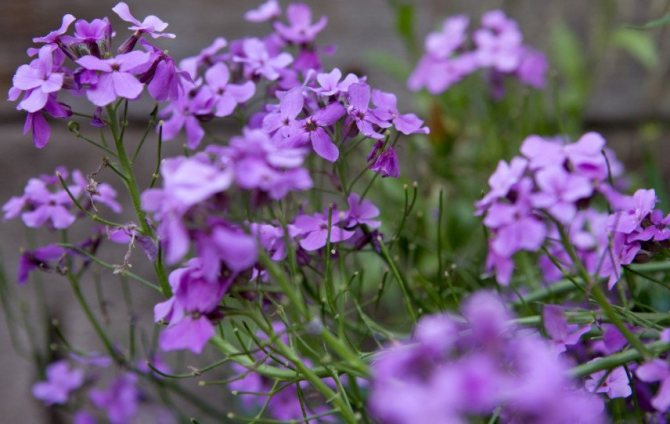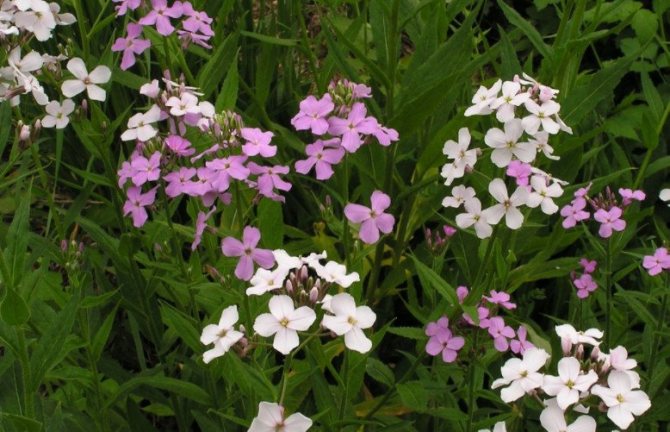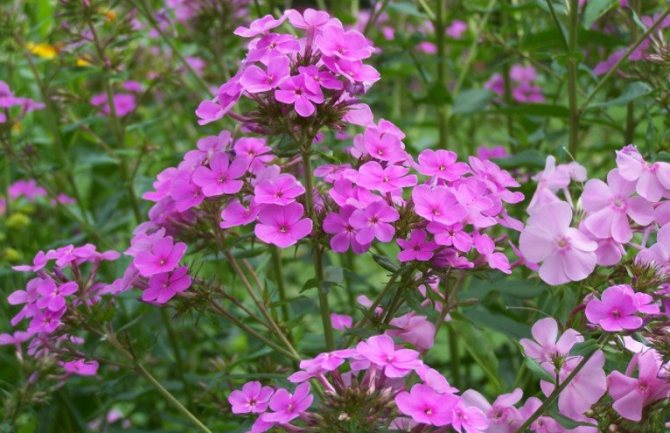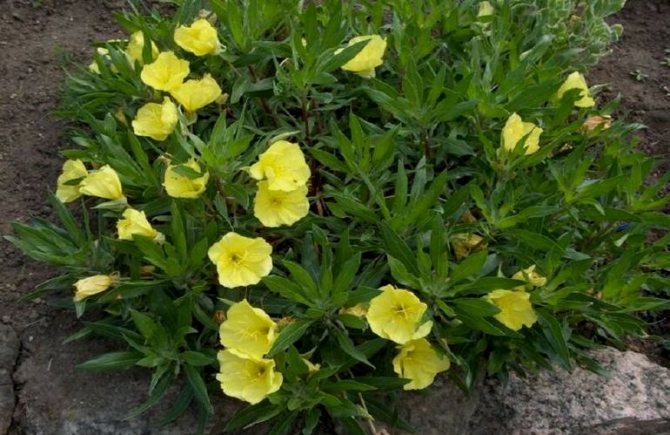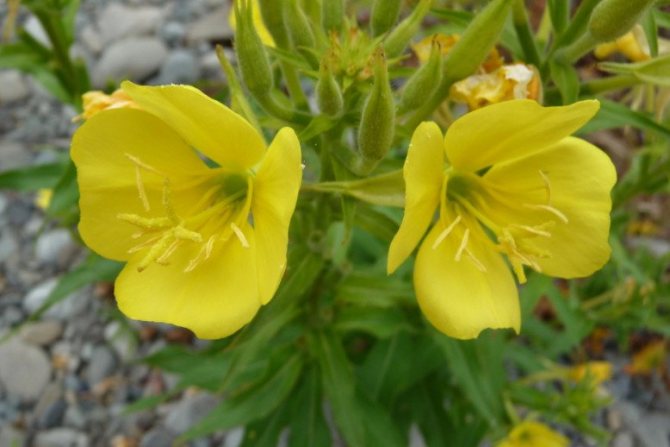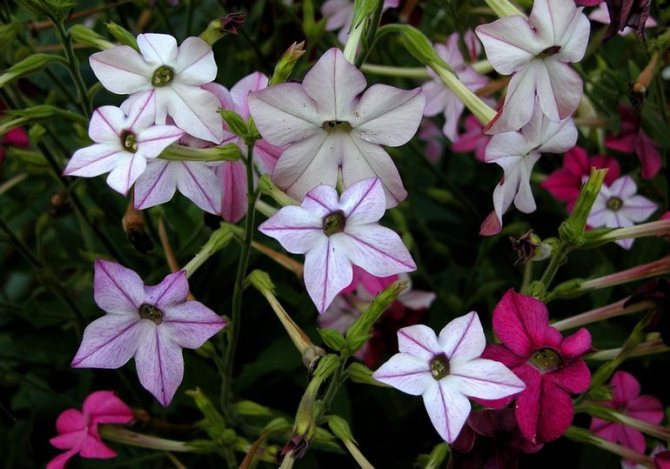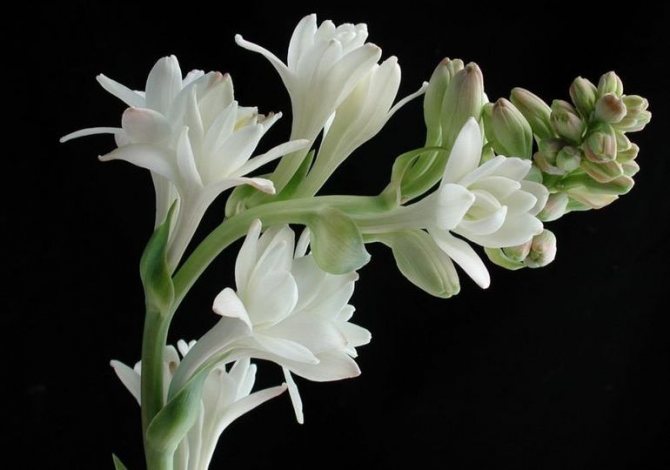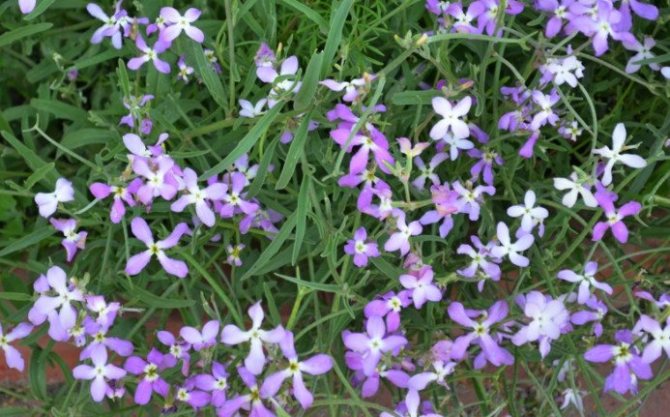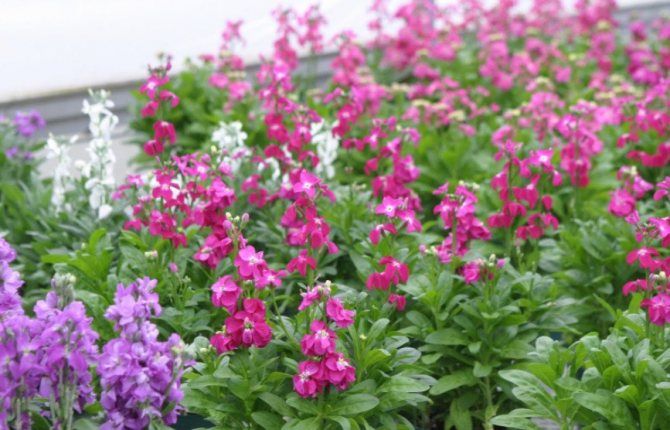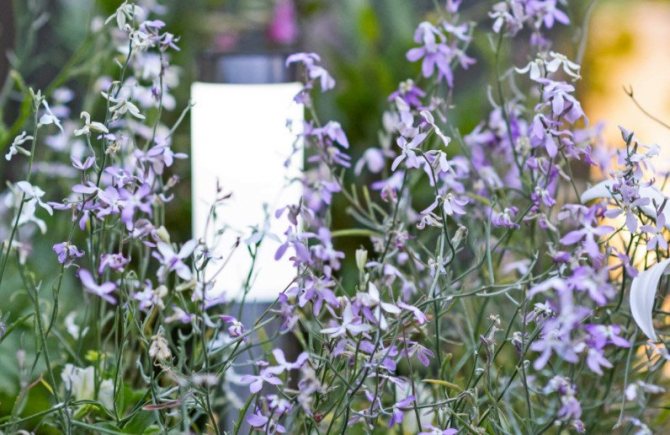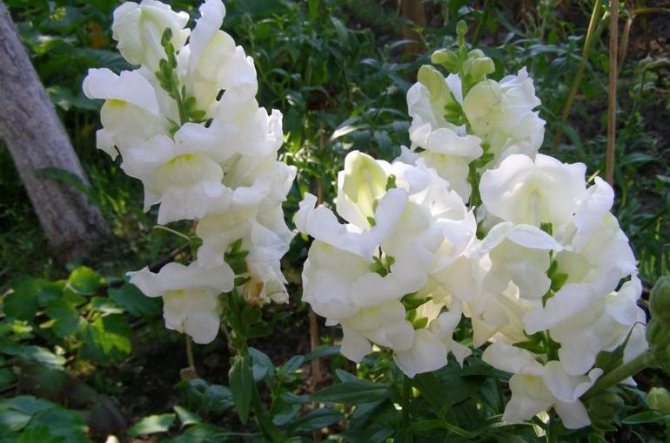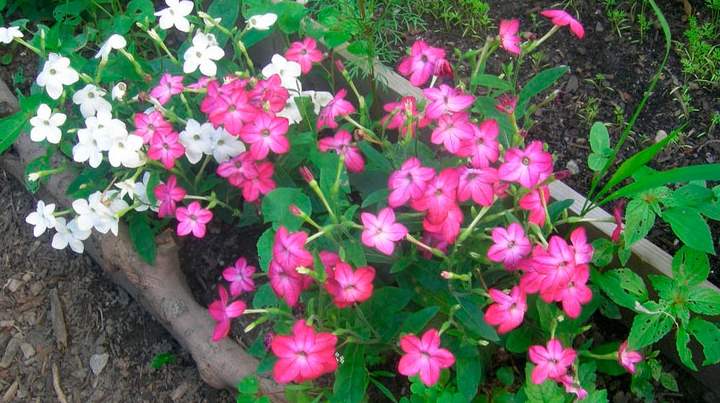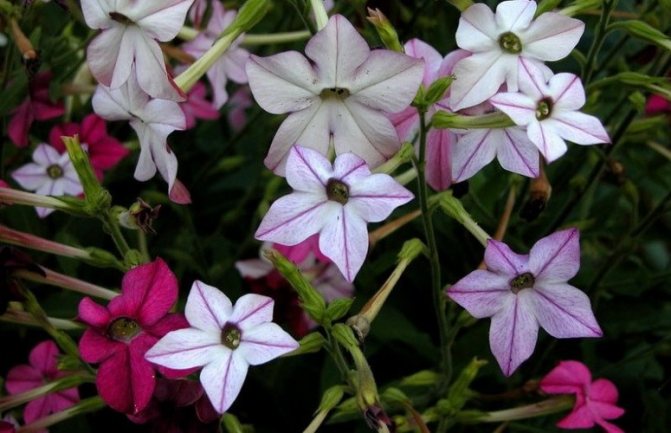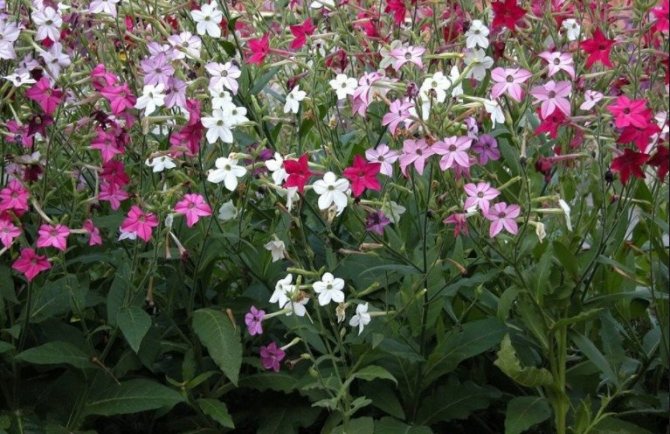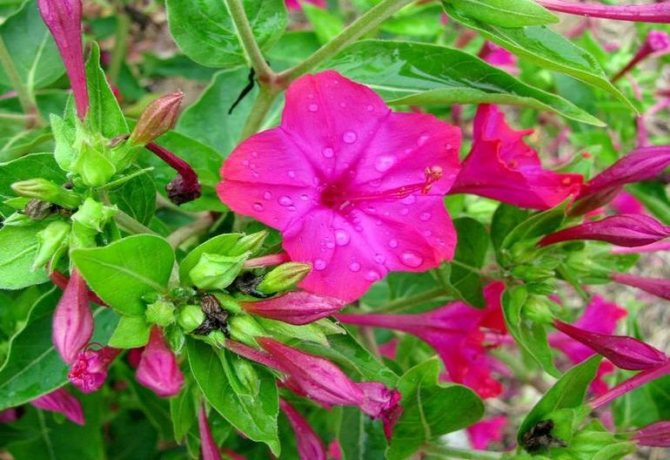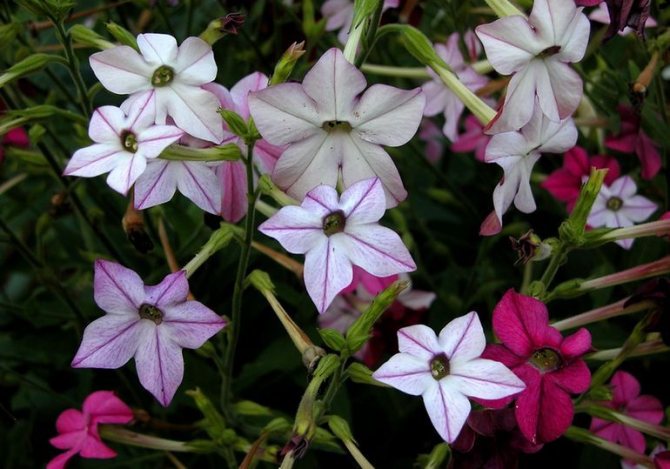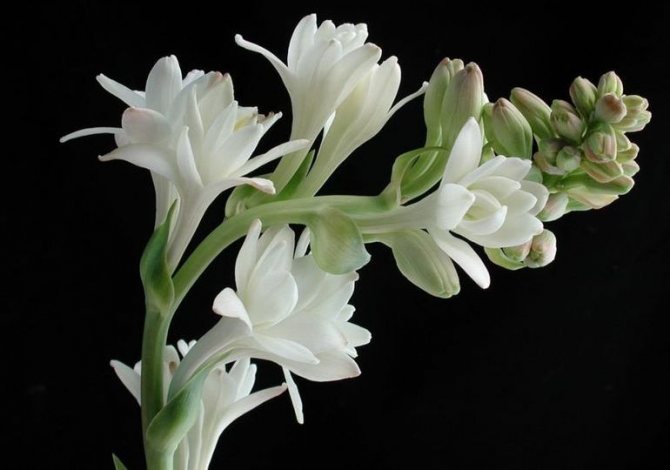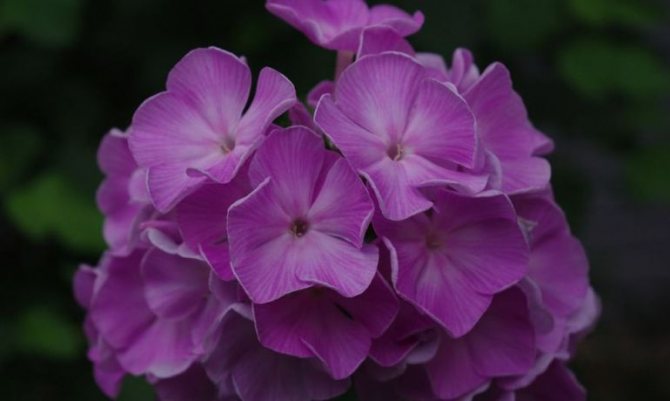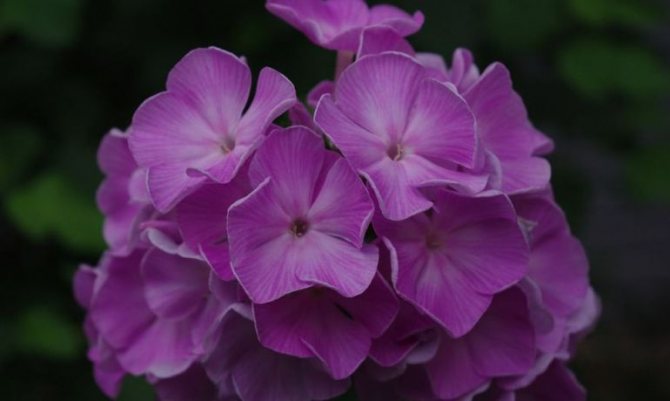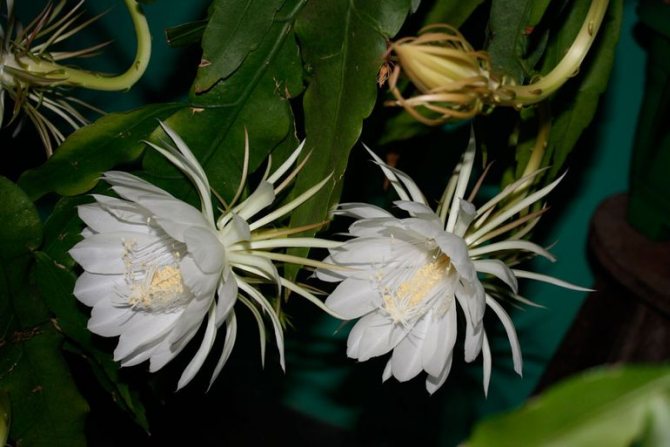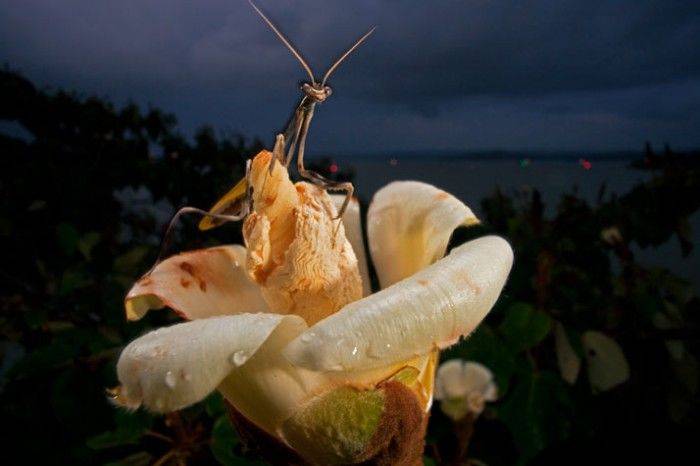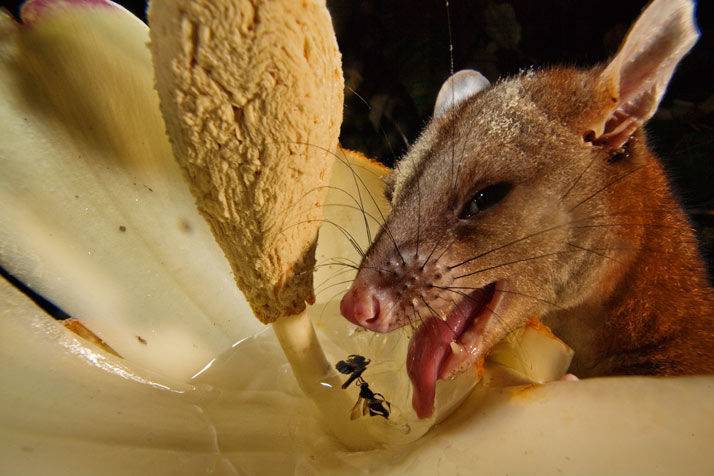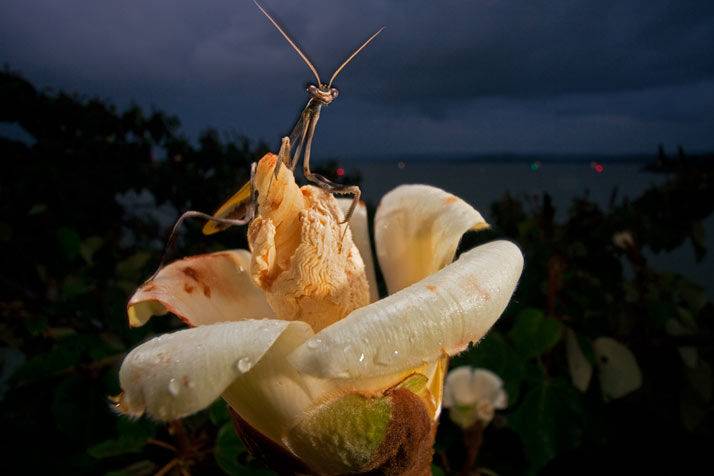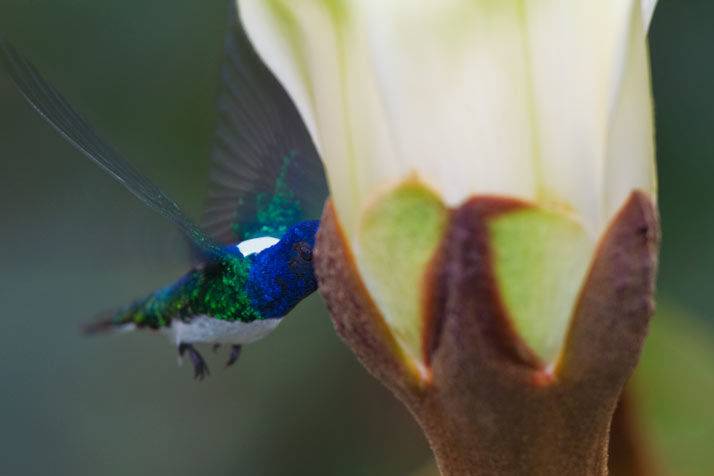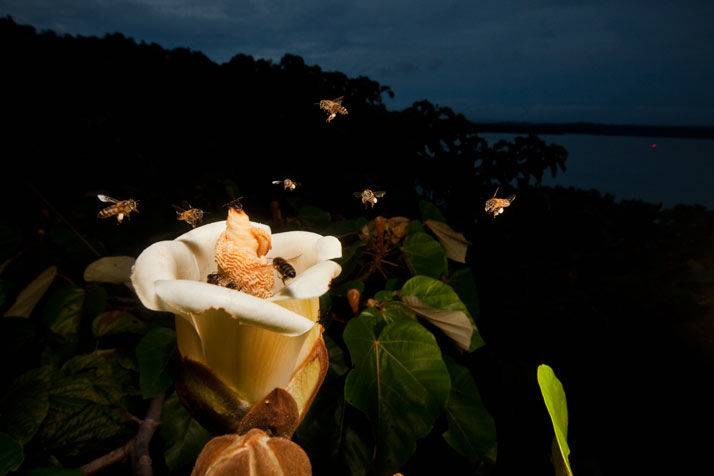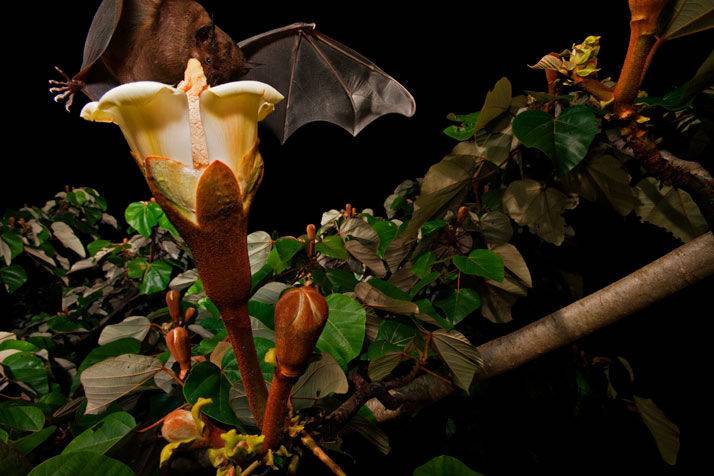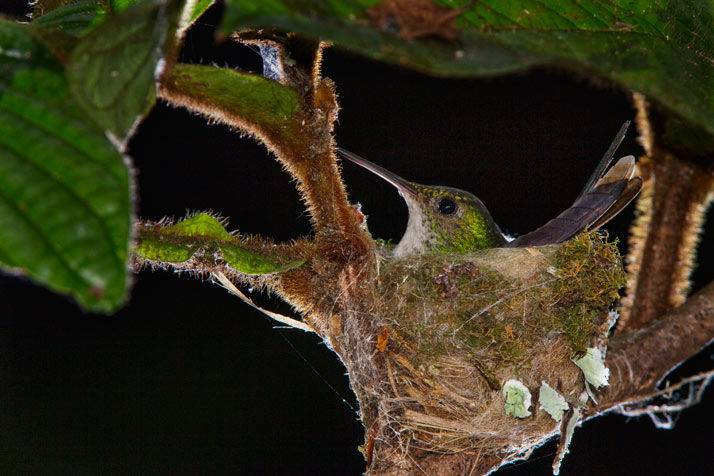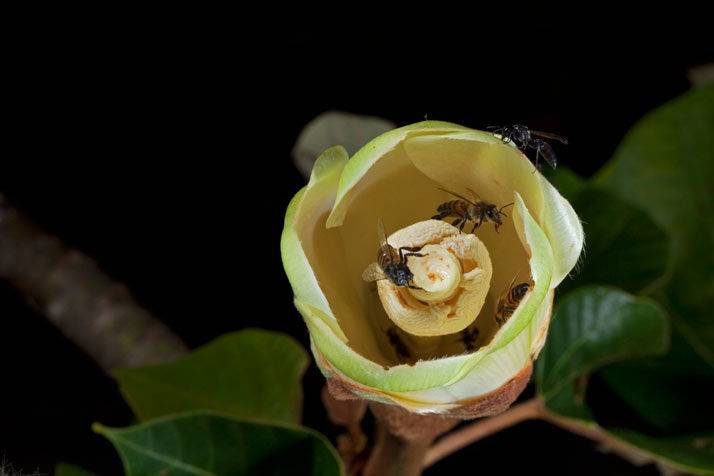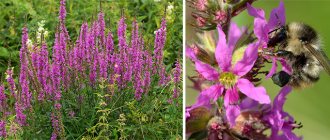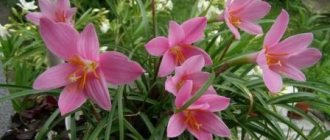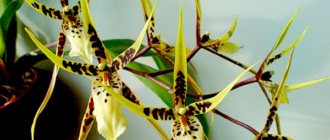There is a huge variety of plants, thanks to which there is always the possibility of creating variegated and unusual flower beds.
Most flowers bloom during daylight hours, but there are nocturnal plants that begin to smell and bloom at night. Some of them bloom day and night. Nocturnal plants are pollinated by insects and small mammals such as bats. Houseplants that bloom at night pollinate themselves or require artificial pollination.
Among the most famous nocturnal plants is the nocturnal violet or hesperis (popular among the people). With the onset of evening, the crimson nocturnal flowers begin to smell intensely. Vechernitsa belongs to biennials, perfectly tolerates winter cold without additional shelter.
Perennial evening primrose also appears in all its glory only in the evening. The large flowers have a pleasant aroma that fills the entire garden. Evening primrose requires some care and attention. Evening primrose is used to create rocky slides, curbs, mixborders.
Annual Matthiola is grown for its beautiful flowering. In the evening, the honey aroma of flowers intensifies. It is especially pleasant to spend evenings in the gazebo, next to which the mattiola is planted. It is often used for landscaping balconies.
Fragrant tobacco is one of the nocturnal plants. This annual is distinguished by unobtrusive, but bright flowers, as well as a special aroma, which intensifies in the evening. Fragrant tobacco pleases with flowering throughout the day and night.
Selenicereus cactus blooms exclusively at night. The flowers are large and fragrant. No wonder he is called the queen of the night.
As soon as night falls, the Zalusian is in all its glory. Its flowers give off a pleasant aroma reminiscent of vanilla.
The amazing mirabilis blooms in the late afternoon and for the whole night, while the air is filled with a unique aroma. By the morning the flowers wither, but the next night new ones bloom, but due to their daily blooming, the impression of a continuous, prolonged flowering is created.
Epiphyllum is also called the queen of the night for its beautiful flowers, which are white, red, pink, cream, yellow.
Night plants include the wonderful brugmansia, whose flowers resemble huge gramophones. With proper care, brugmansia will delight you with abundant flowering. However, there is a danger behind the beauty - the plant is among the poisonous.
Garden night plants create an atmosphere of romance, especially if you go out into a garden filled with aromas of flowers, sit in a lighted gazebo with a cup of tea with loved ones. They bring mystery and enigma to the garden, which gives the impression of something magical and unique.
Flowers open only in the evening, exuding a pleasant orange scent, and close in the morning. The plant itself is perennial, but we grow it as an annual. Reproduces well by self-seeding
When the drifting twilight of lilac moonlight falls to the ground, when the bright colors of flowers gradually merge in the garden with darkness, night beauties enter the arena, who, in the light of the night moon, demonstrate their outfits, fill the garden with a delightful aroma and make the garden uniquely mysterious and fabulous.
Shows his decoration first evening primrose (oenotera) biennial.
Its large fragrant flowers with silky yellow petals unfold almost before our eyes. Evening primrose blooms at the same time, acting as a natural clock. The bush sways slightly, as if from a breeze, and at the same time shows us dozens of flowers opening up as if by magic, over which hovering moth moths, reminiscent of fabulous birds, gather. Biennial evening primrose reproduces mainly by seeds. In the first year, the plant forms a green rosette, which hibernates, and only in the second year the bush blooms. There are exceptions when the plant blooms in the year of sowing. Evening primrose in culture are unpretentious, winter-hardy, drought-resistant, feel great both in the sun and in diffused shade. In cloudy weather, it can please you with daytime flowering. To achieve a focal spot in your garden, it is advisable to plant an evening primrose in a group, and these girlfriends will stand performing their mission, exuding an evening aroma and streaming with a mysterious golden light. Another evening garden charm is
Mirabilis
(mirabilis jalapa), popularly called the Night Beauty.
Flowers open only in the evening, exuding a pleasant orange scent, and close in the morning. The plant itself is perennial, but we grow it as an annual. It reproduces well by self-seeding. The height of the plant, depending on the variety, reaches 30-100 cm. Flowers are funnel-shaped, single or collected in 3-5 pieces in inflorescences of white, yellow, red or bicolor. Flowers of different colors can appear on one plant. Loves enough fertile soils, prefers sunny places, warmth-loving. It seems that the flower phonographs are about to start ringing ..
But shy matthiola
(mattiola) cannot shine with its chic outfit, but this is compensated by the unique scent that we remember from childhood.
And such a longing covers for the irrevocably gone past. It goes well with matiola, the complete opposite of it along the side, but with a very similar aroma of Levka. Vechernitsa (hesperis), an ancient fragrant plant, whose smell is especially pronounced in the evening and at night, is also in a hurry to shine with its splendor. It is grown here as an annual. or a short-lived perennial. Popularly, this plant is called the Matrona's Evening Party or the Night Violet. It blooms with white, pink or mauve flowers, up to 60 cm high. It propagates well by sowing seeds directly into the ground. Fragrant flowers attract an incredible number of moths. Prefers partial shade and well-drained soil.
The final chord in this wondrous show of night fragrances let us give scented tobacco
, taking the imagination into a mysterious fairy-tale world.
Fragrant winged large-flowered tobacco (nicotiana alata) has a height of up to 100 cm. The flowers are large, 5-6 cm in diameter, white, cream, pink. They open at night and in cloudy weather. Grows well in sunny places. Prefers moist loams, propagated by seeds and seedlings.
So that the garden of night flowers and aromas does not look boring during the day, we will add to the flower garden fragrant plants flowering during the day, such as phlox paniculata, hosta plantain, which blooms from mid-July to late August, unpretentious (non-hybrid) petunias, spring bulbs ( hyacinths, daffodils, tulips), you can add fragrant species of lilies. For a fragrant garden, you can choose plants for every taste. It is advisable to place such a flower bed near a gazebo or a terrace, this will make it possible to sit at the table in the evenings, with friends or family, to breathe in the unique aroma of the night garden and admire the "kardeballet" of night butterflies soaring above the plants that attract them.
Evening primrose flower, evening primrose, night candle, onager ... This plant has many names, but its beauty cannot be conveyed in words.
Enotera is a very vivid rhizome plant that belongs to the Cypress family.
It blooms very beautifully, and reaches a height of 120 cm. This genus has about a hundred species of 1-year-old, 2-year-old and perennial plants. They can be both very small and tall. You can find this flower in Central America and Europe.
What do they look like?
If you see the flowering of a primrose (evening primrose) at least once, you will never forget about it. The stems of the night candle fall firmly downward, they can be straight or creeping. Leaves are oval-elongated, their petiole is short. It's funny that they look like donkey ears, which is why one of the names of this flower is primrose. The smell of flowers is very delicate, and the color can be pink, lemon yellow, white and even blue.
Bloom
These flowers bloom in the pre-twilight time, evening primrose blooms very quickly, in a matter of minutes. Her life is very short - just one night. In the morning you will find a wilted bud, and in the evening she will again give everyone her bright light, shining like a candle. In cloudy weather or in the shade, a night candle can bloom during the day. It blooms throughout the summer. In place of a flower that has already bloomed, a solid box with seeds appears. They will mature by September and will be up to 4 years old.
Care
This flower is very fond of the sun, although the light shade of the trees will not harm it. It is very unpretentious to the soil, it can grow in the garden, and in clay and sandy soil. All plant species are very drought tolerant. Excess moisture leads to the fact that the roots begin to rot, then the flower dies. Watering is necessary only during periods of severe drought. This plant is not susceptible to disease, of course, if it is properly cared for. Evening primrose is very good at transplanting.
Among the etoners there is such a species, the fleshy root of which is used as a vegetable, it is called "Oenothera biennis", "rapontica", "rapunzel".
Vechernitsa
- Perennial
With the onset of evening, it is impossible to pass by this lovely flower! The cool sweet aroma of nocturnal fatigue removes traces of fatigue, gives warmth and joy even on the worst day. Large lilac brushes look spectacular both on a flower bed and in a bouquet, enchanting with their romantic appeal.
Growing conditions: perennial nocturnal is extremely unpretentious. Sowing to a permanent place in June. Grows best on loose soil, in full sun or partial shade. Hibernates without shelter. Transfer: September.
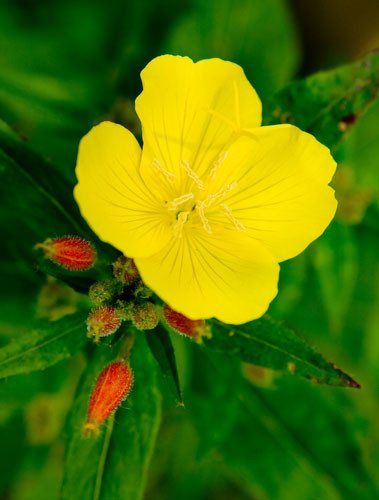
Lotus Brahma-Kamal
Flower of the gods - this is how this extraordinary nocturnal plant is called in India. This lotus is mountainous, it is also called bitter. It grows high in the mountains at an altitude of 4.5 thousand meters above sea level, where it is always very cold.


Lotus Brahama-Kamal is so named after the Hindu god of creation Brahma. Its white large flowers delight the human eye with their flowering for a short time, since the lotus blooms only one day a year and only at night.
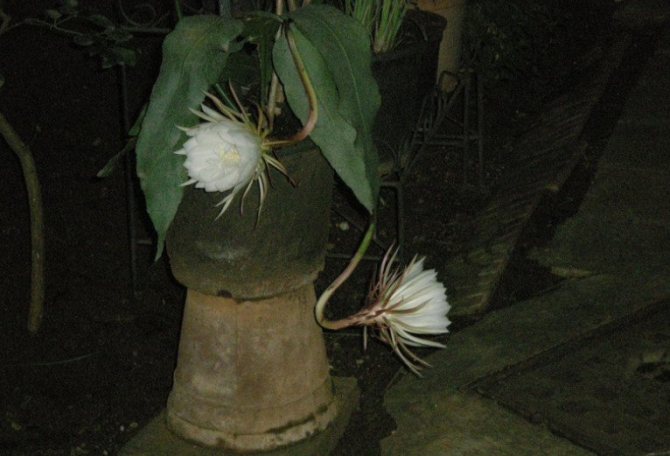

With the onset of dusk, its petals open - and this is a very rare occurrence. In India, it is even believed that if you are lucky to see a blooming Brahma-Kamal, this is to success and good luck in all matters.
Enotera
- Perennial
Large cupped evening primrose flowers with delicate silky petals will envelop the garden with a pleasant aroma after sunset. To emphasize the discreet beauty of evening primrose, it is combined with astilbe, bells, veronica, lobelia, creating fashionable flower beds in a natural style. Well suited for rocky gardens, mixborders and curbs.
Growing Conditions: Evening primrose is fairly easy to grow. Sowing in early spring directly into open ground.Prefers open, sunny locations with well-drained soil. Watering is necessary in dry weather. Loves feeding.
Night gladiolus
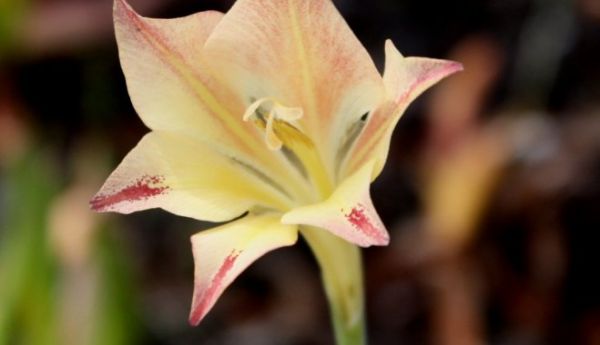

Gladioli are great! Each time you are amazed how a tiny bulb, planted in spring, by the end of summer, can turn into such a luxurious plant, covered with many flowers and like short blades of leaves! Translated from Latin, "gladiolus" means "short sword".
More than 260 species of gladioli are found in the world, and since the beginning of the 19th century, when work on the selection of gladioli began, more than 10,000 varieties of these beautiful flowers have been created. More than 1000 of them can be found in Latvia.
Mattiola
- Annual
This flower has long been grown not only for the sake of beauty, but also for the wonderful honey aroma that mattiola exudes all night (no wonder its second name is night violet). The color of the flowers ranges from pale pink to deep purple. If you plant this flower in a container on the balcony, your apartment will be filled with a wonderful sweet fragrance every evening.
Growing conditions: Matthiola is extremely cold-resistant, it can withstand frosts down to -7 ° C. Prefers sunny, well-drained, fertilized soils. Sowing to a permanent place in late April - early May.
Wonderful mirabilis
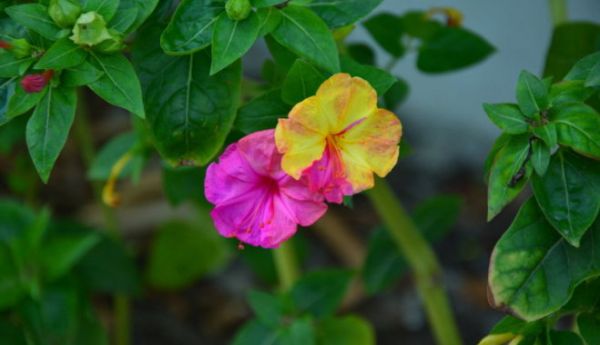

Mirabilis jalapa is the most common representative of this species. Usually mirabilis flowers open in the evenings, exuding a strong sweet scent.
But the most amazing thing is not even this, but the fact that even on one mirabilis bush there can be flowers of different colors. In this wonderful plant, the flowers, growing up, change color - from yellow, for example, to dark pink, and whites can turn into purple.
Mirabilis flowers are used as food coloring. Its leaves are conditionally edible (it is better to eat them only when there is nothing else). Traditional medicine uses mirabilis as a laxative, a remedy to heal wounds and relieve swelling.
It is believed that mirabilis root improves potency, the main thing here is not to overdo it - do not forget about the laxative effect!
Scented tobacco
- Annual
The dazzling bright color of fragrant tobacco will decorate your garden until the very frost. Large flowers, reminiscent of gramophone, are open all day, and in the evening they begin to emit a subtle pleasant smell. Fragrant tobacco is recommended for decorating various flower beds and sunny balconies.
Growing conditions: This heat-loving plant is grown using seedlings (seeds are planted in March-April). Landing in open ground in May-June, when the threat of frost has passed. Tobacco is undemanding to soil and care. Place it on moist, moderately fertile, light soil in the sun or in partial shade.
Plants also have a biological clock. Each plant "wakes up" in its own time. There are “nocturnal” flowers that open their petals at night. At exactly 8 o'clock in the evening, it reveals its bright yellow evening primrose petals. Around the same time, flowers of scented tobacco bloom, and after 9 o'clock - flowers of mattiola.
What garden flowers bloom only at night?
Mattiola or night violet
- an annual, ground cover plant. This flower has long been planted near gazebos, benches, terraces for the sake of the wonderful honey aroma that mattiola exudes all night (no wonder its second name is night violet). The color of the flowers ranges from pale pink to deep purple. If you plant this flower in a container on the balcony, your apartment will be filled with a wonderful sweet fragrance every evening.
* Growing conditions
Matthiola is extremely cold-resistant, it can withstand frosts down to -7 ° C. Prefers sunny, well-drained, fertilized soils. Sowing in a permanent place in early spring (late April - early May). Blooms in July. Not afraid of partial shade.
If you want the scent of the plants in your night garden to be more intense, then place them near a wall, gate or trellis.Vertical landscaping will add volume to the garden and spread the smell throughout the area.
Evening primrose missouri
Evening primrose garden flower Evening primrose flower has another name - "night candle". The effect it produces when it blooms remains in memory for a long time. After sunset, evening primrose comes to life, filling the garden with a pleasant aroma. Many buds, rolled into tubes, unfold within two to three seconds and turn into large yellow flowers, up to 7 cm in diameter, shaped like a saucer. In the morning, after night flowering, evening primrose appears in all its glory. Before lunchtime, insects manage to visit it, after which the flowers close. In the evening, new ones bloom - and so all summer, from June to frost. On cloudy days or in the shade, the flowers are open during the day.
To emphasize the discreet beauty of evening primrose, it is combined with astilbe, bells, veronica, lobelia, creating fashionable flower beds in a natural style. Well suited for rocky gardens, mixed curbs and curbs.
* Growing conditions
Evening primrose is fairly easy to grow. Sowing in early spring directly into open ground. Prefers open, sunny locations with well-drained soil. Watering is necessary in dry weather. Loves feeding.
Fragrant tobacco
an annual plant with a straight thin branched stem up to 80 cm high. The leaves are large, basal - rounded, stem - elongated. The flowers are regular, non-double, single. The flower is star-shaped with a long tube. The color of the main species is white, but there are varieties with light lilac-pink, lilac-red and transitional colors. Fragrant tobacco is valued for its pleasant aroma, which intensifies in the evening and in cloudy weather, since the flowers usually close in the sun during the day.
Will bloom in spring tulips
if you don't dig the bulbs and they spend the whole summer in the ground? They will bloom, but without drying the bulbs, the flowering will be less intense. In addition, the replacement tulip bulb is formed every year deeper than the old one, that is, the plant gradually sinks into the ground. Deep-seated bulbs bloom later, or may not bloom at all.
What to do to bloom imperial hazel grouse
? It is possible to stimulate the flowering of hazel grouse if the bulb is planted not vertically, but at an angle of 45 degrees. This redistributes nutrients in it and leads to the laying of a flower bud.
Perennial evening party
also enhances its scent towards night. Extremely unpretentious. Sowing to a permanent place in June. Grows best on loose soil, in full sun or partial shade. Hibernates without shelter.
For growth and development, all plants need sunlight: most representatives of the kingdom of Flora open up to meet him early in the morning, and at dusk the buds tightly close. However, there are originals in nature - flowers blooming at night: walking along the dark alleys or a garden, you can catch their heady aroma. You probably yourself have inhaled it more than once: without such plants it is already difficult to imagine parks or embankments.
Nottingham flycatcher
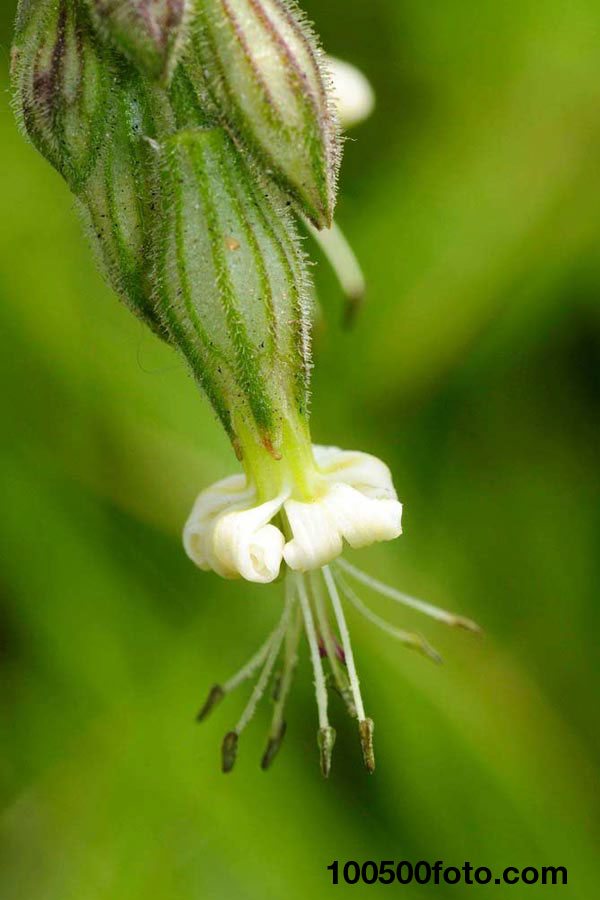

This plant has flowers with a white or pinkish tint, as well as hairy leaves. Its strong scent fills the evening air, attracting nocturnal insects. Once upon a time, the walls of Nottingham Castle were decorated with these beautiful flowers. Hence the name of the plant. However, during renovations in the 19th century, the flowers were destroyed.
These beautiful delicate flowers that bloom at night are a perennial plant. Their botanical name is Mirabilis Yalapa. They bloom in spring and summer. Four o'clock comes in red, white, pink, blue and yellow. Such flowers begin to bloom at four o'clock in the afternoon, which is why they got their name. These flowers make great hedges. When they bloom, they give off an excellent aroma. The birthplace of Mirabilis Yalapa is Mexico.
So what flowers bloom at night?
The magic of mattiola scent
Do not be deceived by the modest appearance of this flower - this is a real queen of fragrance in front of you. Mattiola two-horned is valued precisely because it literally saturates the air with its aroma in the evening and at night. In addition, this plant is very unpretentious. It can grow even at relatively low temperatures. Sow it in April to admire the delicate lilac buds and inhale their sweet scent on June evenings. With proper care, it will delight you until October.
Mirabilis: night beauty
This vibrant diva, a native of Mexico and South America, "wakes up" only in the afternoon, when the sun slowly sets below the horizon. Lush bloom gives a rich, pleasant aroma.
It got its name mirabilis ("amazing") for its unique property: one plant is capable of producing buds of different colors. Dissolving, they delight the eye with bright colors - from orange to deep pink.
African princess of Zalusian
This graceful overseas visitor is also referred to as the nocturnal phlox. Opening delicate white-pink buds in the evening, it exudes a delicate unique aroma, in which some people catch notes of vanilla.
Like many flowers that captivate people with their scent, they are often grown in hanging vases and balcony boxes.
Selenicereus: Queen of the Night
A creeping plant in the cactacea family that produces a fragrant flower that blooms at night. Grows in Mexico, West Indies and the southeastern United States. Today, if there is a bright spot in the room, you can make it an inhabitant of your home. The plant is unpretentious, although it loves abundant watering. In any case, its fabulous flowers, which combine the gold of sepals and the white silk of the petals, will pay off with their splendor care and attention.
Unique balsa wood
Finally, I would like to tell you about the amazing balsa tree. You will not find it here - it grows in South America. Its wood is the lightest in the world. However, large flowers that bloom at night also make the tree interesting. The photo conveys all the diversity of life centered around the buds that opened after sunset. They attract a variety of insects and even animals! Sweet nectar, which contains about 30 grams in one cup, is drunk by bats, olingo, kinkajou, possums. The flower is pollinated by hummingbirds, bees and other insects.
Flowers with a strong aroma and beautiful long flowering are a real decoration of the garden and backyard flower beds. Recently, scented plants have also become especially popular and are widely used for home and interior decoration.
Water lilies blooming at night
Such wonderful tropical flowers blooming in the pond at night will definitely not be ignored. How good are these red, pink or purple water lilies blooming in the evening twilight. A beautiful bright flower looks very impressive against a dark background. Tropical lilies are larger than usual, and their color is more intense. The flower reaches 7-10 inches in size. Each flower has about 19-20 petals, a faint, not very pleasant smell emanates from them.
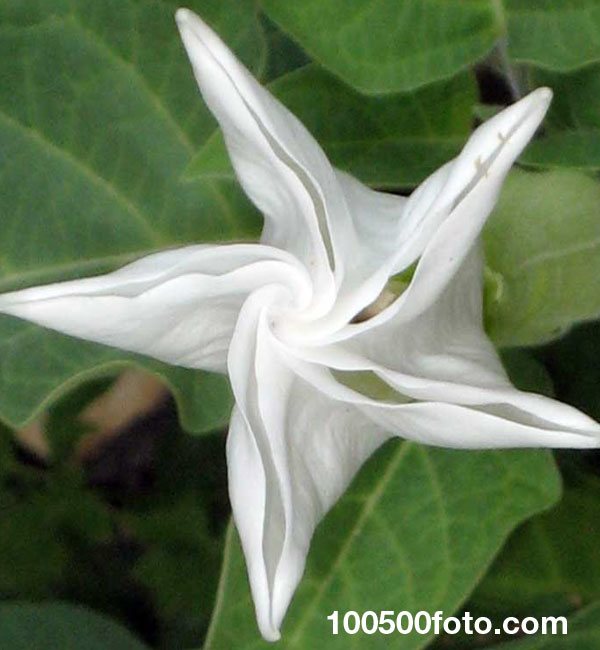

Moon flowers (the botanical name for Ipomoea) get their name from the fact that they bloom in the moonlight. These flowers are pink or white. In the dark, morning glories open quickly and are in loose form all night long. As soon as the sun's rays touch their petals, they immediately close. This plant reaches 15 feet in height. Propagated by seeds.
Night gladiolus (the botanical name for gladiolus Tristis) is a creamy yellow flower with a very pleasant spicy aroma. It is usually grown in dense urban areas with a lot of rainfall, and it also grows in high mountain areas. The height of the night gladiolus is 36-48 inches.It blooms from late spring to mid-summer. You need to be careful with this plant, as certain parts of it are poisonous and can cause irritation or allergies.
You've probably seen these flowers. Casablanca is widely used in perfumery and weddings. It belongs to the genus of lilies, numbering more than 110 varieties. Each flower has 6 petals and colors range from white, yellow, purple, orange to pink. Just imagine how beautiful it will be if you plant all the colors of this lily in the garden. Casablanca's flowers are elegant, delicate and also smell great.
Popular garden flowers with a strong scent
For the summer residence, fragrant annuals and pleasantly smelling perennials can be used. To get a spectacular and fragrant flower bed for a long time, you need to know what the most unpretentious garden plants form a fragrant flower.
The most fragrant flowers for the garden
Garden fragrant flowering crops can be annual and perennial, which allows you to create attractive compositions:
- sweet pea
- an annual plant with a pleasant pronounced odor. Differs in a variety of colors, which helps to create front gardens or pots in different styles and colors. Varieties and hybrids of the bush type look spectacular on flower beds and ridges;
- flowers Alyssuma
or sea lobularia smells like honey and are not afraid of spring frosts, therefore they are ideal for growing in cold regions; - undersized Lily of the valley
grows well in the shade. This perennial plant forms small flowers and goes well with peonies and carnations; - the most common daffodils
white-colored and yellow-colored varieties have a very delicate and very refined aroma, which new varieties and hybrid forms are devoid of; - spring Hyacinths
especially popular in early flower beds and flower beds. The plant is represented by numerous varieties with all kinds of flower colors, which allows you to choose the best option for decoration;
- shade-loving viola
it is best to sow before winter, which improves resistance to negative weather factors. This is an ideal solution for decorating difficult-to-cultivate areas and tree-trunk circles of garden plantings; - many varieties Carnation
They are distinguished by flowers with a persistent scent, which is able to effectively repel mosquitoes and many plant pests. The most unpretentious types are lush, blue-gray and feathery carnations.
Lilies, roses, chrysanthemums and peonies blooming profusely with fragrant flowers are no less popular with gardeners.
Flowers that smell at night
The flower, fragrant in the evening, is popular in the design of the backyard and flower beds located in the immediate vicinity of the house. Night flowering plants or ornamental crops that smell amazing at night:
- tropical annual Mirabilis
is able to bloom profusely throughout the summer season, and forms deliciously smelling delicate white, pink, red and yellow inflorescences that open in the evening; - evening relatively small fragrant flowers tobacco
not only attractive but also very aromatic. The most popular varieties include winged, forest, and jasmine; - name Mattiola
known to many amateur flower growers. This annual opens flowers to smell in the late afternoon and does not tolerate sunny areas, therefore it is sown in flower beds and in flower beds in the shade of lilac or dahlia;
- flowering Levkoy
is a relative of mattiola, but a significant difference is represented by magnificent flowers that have many shapes and colors; - garden Fragrant mignonette
especially highly appreciated by landscape designers for the beautiful shape of the leaves and the pleasant unusual aroma that persists at night; - night violet
or female hesperis - the most common decorative type of violets in home gardening, characterized by abundant flowering and a characteristic pronounced aroma.
The annual Moonflower is best suited for decorating an evening garden, and its delicate aroma intensifies after sunset. The plant is best suited for areas with hot and sunny climates.
Fragrant flowers for the garden (video)
Spicy herbs and scented plants
Spicy-aromatic fragrant plants with characteristic healing properties are widely cultivated in most regions of our country. The most popular plants are:
- Peppermint
, long-leaved, curly, garden and apple is perfect for growing in garden plots, and is a valuable ingredient in salads, soups, meat dishes, various drinks and homemade baked goods; - Melissa
medicinal is a popular perennial essential oil herb called lemon mint, which is due to the pleasant scent of lemon, which remains in the plant even when dried; - Catnip
or catnip - a culture not only useful, but also very decorative, thanks to purple or lilac flowers, as well as grayish-blue leaves;
- Oregano
or origano refers to a beautiful ornamental plant with a very pleasant aroma that intensifies on sunny days. The flowers are attractive lavender or pinkish; - common, creeping or lemon Thyme
known as thyme or Bogorodskaya herb and has a delicious smell and spicy taste; - Hyssop
or St. John's wort blue refers to a subshrub herb with a tart taste that blooms with attractive spike-shaped blue inflorescences; - essential oil and decorative Monarda
or garden bergamot refers to medicinal and spice-flavoring plants, and cut bright red, pink, are great for composing.
- medium-sized spicy-aromatic Lovage
has very beautiful leaves of the pinnately dissected type and can become a real decoration not only for garden ridges, but also for flower beds; - perennial spicy Fennel
has bluish-green split leaves and a characteristic, very pronounced smell of anise, due to which it is widely used in soups, vegetable, fish and meat dishes; - Tarragon
known to many under the name tarragon. The leaves of this medium-sized plant are widely used in a variety of French fish dishes and poultry.
No less popular among domestic gardeners and gardeners are such spicy and aromatic crops as dill and basil.
Mirabilis
Night beauty, or mirabilis, is a herb from the niktagin family. It happens both one-year and long-term. Grows in the form of a sprawling tall bush, reaching 1 m in height.
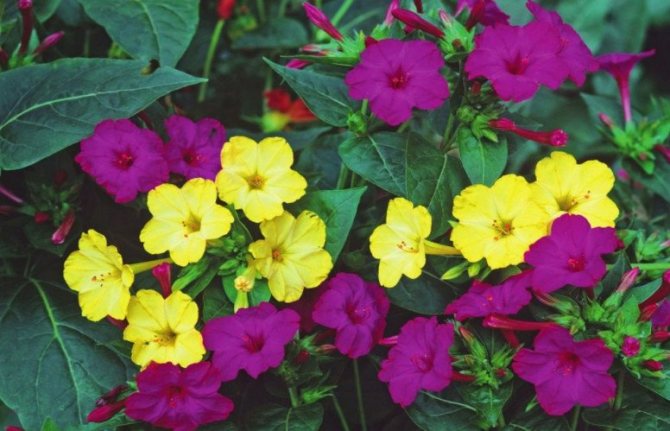

The leaves of the mirabilis are ovoid or oval, opposite, petiolate. From above, the plate looks glossy, smooth and shiny. The color is dark green, but there is a lighter vein in the center of the leaf.
Fragrant flowers for indoor cultivation
In the conditions of modern indoor floriculture, not only highly decorative, but also fragrant plants with a long flowering period:
- or Stefanotis belongs to the subshrub vines, and prefers good lighting. The star-shaped white flowers have an exquisite aroma, but the perennial requires the use of support and careful regular care;
- capricious fragrant gardenia
needs good lighting, warmth and moisture, therefore it is most often grown only by experienced flower growers; - exotic or Eucharis
has a very pleasant and delicate aroma. differs in large dark green foliage and exquisite umbellate inflorescences; - Hoya
or wax ivy forms flowers with a strong sweetish odor, which intensifies in the late afternoon. Liana is distinguished by its unpretentiousness and drought resistance, and also has attractive leathery leaves and long shoots.
Main types
There are more than a hundred species of this plant. Let's consider the main ones.
Missouri
O. missouriensis is a small perennial flower. It is not too tall, only 30-40 cm, but its effectiveness cannot be taken away. The golden yellow flowers of the beautiful Enothera emit an enchanting scent. They are designed in the form of a cup and are large in size.
Biennial
O. biennis L. is very common in culture. The plant is quite tall, can reach 2 meters. Castings are characterized by a bright lemon color. The delicate scent of this flower only intensifies with the onset of dusk.
Shrub
O. Fruticosa is a perennial evening primrose species. It has high winter hardiness, and grows as a bush up to 90 cm in height. Its stems are very strong and branched, the leaves are very small, dark green in color. With the onset of autumn, they turn crimson. The flowers are also medium-sized, only up to 3 cm. You will recognize them by their bright yellow color.
Fragrant
This species grows in mountainous areas. The plant blooms with yellow flowers with a strong aroma. The scent becomes even stronger with the onset of darkness.
Quadrangular
O. tetragona is highly winter-hardy. The plant is perennial with an erect bush that reaches a height of 45 to 70 centimeters. The leaves are blue-green, oval in shape, by autumn they turn red. This bush blooms with yellow inflorescences in the form of a shield, in bunches. Their aroma is very pleasant. Flowering time is June-August.
Stemless
O. acaulis is an atypical plant for our flora, but it can perfectly adapt to the conditions of Russia. Differs in taproot, refers to a perennial species.
Beautiful
O. speciosa comes from South America. The flowers of the delightful Enotera are very fragrant and pink in color. It is not very stable in our climate, therefore it is less common in culture. The night candle looks very impressive (see photo). Her flowers are made in the form of a bowl, which is directed to the sky. In height, it grows up to 60 cm. This type of night candle begins to bloom in late spring. If the soil is poorly drained, the roots can rot.
Features of growing eucharis (video)
Any parts of the following indoor ornamental crops have a pleasant pronounced aroma:
- coniferous plant Araucaria
often grown at home and is characterized by a pleasant coniferous smell, and is also capable of saturating the air with useful phytoncides; - indoor mint or Plectrantus
highly appreciated by indoor florists due to its unpretentious care and decorative attractiveness of foliage; - evergreen perennial Myrtle
has leathery leaves and single or numerous white flowers, collected in short racemose inflorescences.
When placing fragrant plants in the house, remember that it is not recommended to grow fragrant crops in the bedroom and children's room.
Night water roses
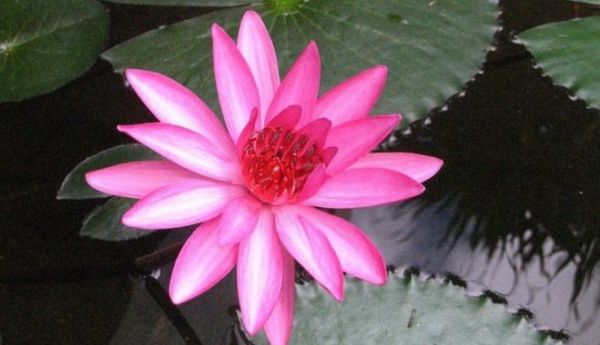

Foto: Flickr upload bot / cc
This tropical plant is hard to miss. Purple-red or pink water roses bloom at sunset, standing out beautifully against the dark water.
These water roses are distinguished by their hardiness and larger flowers - their petals are 19-20 centimeters each, flowers can reach 25 centimeters in diameter. At night, water roses exude a faint but pungent scent.
Fragrant ornamental shrubs and trees
This category of decorative fragrant crops is in great demand in the design of the backyard landscape. Many fragrant ornamental shrubs and trees go well with flowering and decorative deciduous annuals and perennials.Especially popular in the decor of the backyard area are:
- Tall decorative witch hazel
, which in early spring forms a huge number of yellow-orange flowers with a characteristic almond scent; - Unusually attractive Magonia Bilya
it has a pronounced lily of the valley aroma, and reaches a height of two meters; - Undersized ornamental shrub Daphne
ordinary blooms in early spring, immediately after the bulk of the snow melts, and with its aroma resembles a garden lilac; - The tall, unpretentious one reaches a height of 6-7 meters and is distinguished by early spring flowering with inconspicuous flowers that have a characteristic smell of cinnamon, vanilla and caramel;
- Medium spikelet Corilopsis
blooms in early spring with attractive yellow flowers with a slight scent reminiscent of primrose; - Tall and widespread bird cherry
blooms in abundant and large white inflorescences in the last decade of spring; - Undersized shrub Fothergilla
mountainous has a strong honey smell, exuded by white May inflorescences; - Medium height Japanese skimmia
differs in white flowers with a relatively subtle lily of the valley smell;
- Lilac and Chinese
forms inflorescences of various sizes and colors with a rich lilac smell; - Tall Rhododendron yellow
has a sweetish smell that comes from golden sorlores that bloom in the last spring decade; - A characteristic strong smell has a medium-sized and unpretentious ornamental shrub Crown chubushnik;
- Popular Honeysuckle honeysuckle
distinguished by long shoots and yellow flowers with a pleasant honey scent; - A spicy and very pronounced smell has a profusely flowering medium-sized garden plant Calicant
blooming brownish red; - The garden plant has a long and very abundant flowering with a spicy aroma, the height of which often exceeds a couple of meters.
Perhaps the most popular and widespread in landscape decoration is still the fragrant viburnum with fragrant pink flowers.
Despite the fact that almost all fragrant flowers are unpretentious ornamental crops, in order to maintain their attractiveness and abundant flowering, they should be provided with full-fledged care. Among other things, it must be remembered that crops with a very pronounced sillage cannot be planted under the windows of a bedroom or kitchen.
Night flowers
on the garden plot - what are they? Types of night flowers: Missouri evening primrose, fragrant tobacco, mattiola (night violet). How to grow night flowers. Let's talk about these today.
Brugmansia
The flowers of this extraordinary plant are called "Angel trumpets"... They are similar in shape to gramophones - oblong-tubular, bell-shaped. The flowers are quite large - in length they can reach from 15 to 30 cm, and be about 17 cm in diameter at the widest open part. And the color can be very different - white and pink, yellow and orange, blue and red.
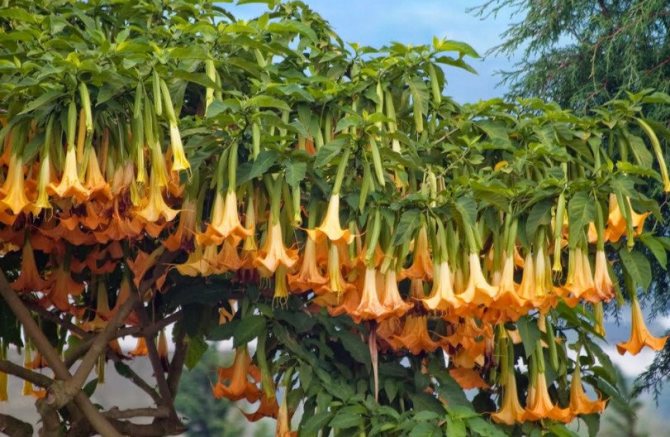

Brugmansia is a tropical herbaceous woody plant. In its homeland, in Latin America, it grows in the form of a small tree, but in our country it is more like a sprawling large shrub with a wide crown. The leaves are large, egg-shaped. Young stems quickly become covered with smooth bark. And large flowers bloom one at a time on thin and long peduncles. They always hang down. There are usually a lot of flowers on one plant during the flowering period, this number can exceed a hundred per bush.
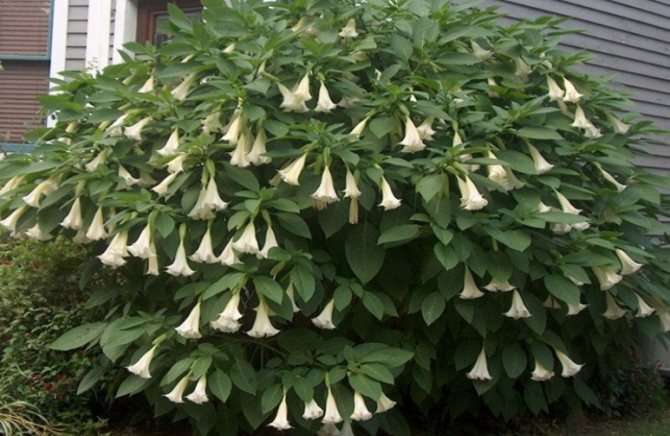

It is noteworthy in this beautiful tree that on hot sunny days the flowers of brugmansia look a little lethargic, half-closed and practically odorless. But as soon as the night coolness descends on the ground, brugmansia awakens, blooms, its flowers open and begin to exude a fragrance.
Learn more about brugmansy: main species, home cultivation, propagation by cuttings and seeds.
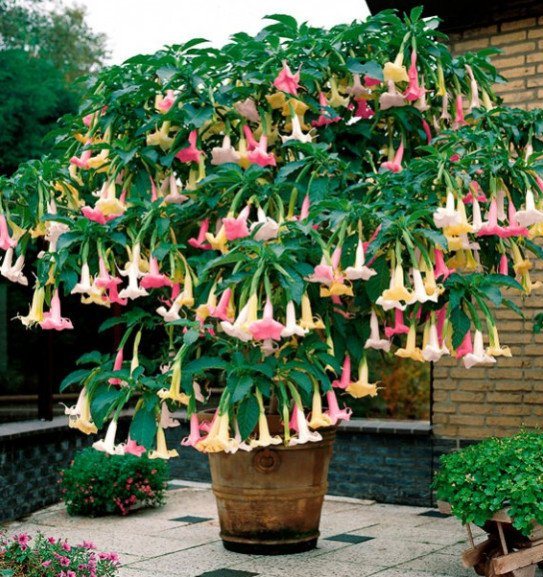

Since the plant is tropical, it is not grown outdoors in mid-latitudes. The breeding method is mainly tubular.
For the summer, this queen of the night can be taken out into the courtyard, to the garden plot, to the cottage, and she needs to spend the winter in a glazed loggia, since a drop in temperature below +10 ° C is detrimental to the flower.
Important! be careful
—
brugmansia is poisonous! This plant is isolated from the genus Datura and all its parts contain dangerous hallucinogenic substances. Of course, you are unlikely to start using brugmansia, but it is better to protect it from children in order to avoid taking a “taste test”.
Night flower
White night flowers
Plants, like humans and animals, have their own biological clock. Any plant "wakes up" at a certain time. Most flowering plants have petals that open early in the morning with sunrise, but there are also night flowers that open their buds at night. For example, Missouri evening primrose flowers reveal their bright yellow buds at exactly 8 pm. At the same time, fragrant tobacco opens its flowers. And after 9 pm
flowers bloom mattiola
(night violets). Now let's take a closer look at each flower.
Night phlox
Another thermophilic plant that can be enjoyed in winter if transplanted into pots and brought indoors. Flowers open in the evening and give their scent throughout the night.
Flowering begins in mid-summer until warm autumn days. Leaving does not require much effort. Loosening the soil and regular watering will be the key to success in growing Zalusian.
It is necessary to transplant seedlings grown from seeds, making sure that there is no further frost.


There are many different surprises lurking in nature. One of them is night flowers. They bloom at night and fill the air with their lovely scent..
Evening primrose missouri
This flower is also called in another way "night candle
". As if in a fairy tale, after sunset, evening primrose flowers from buds rolled into tubes turn in just 2-3 seconds into large yellow flowers, up to 7 cm in diameter. The flowers are like small saucers and emit a very pleasant aroma. One has only to see it once, and you will love this flower forever. After night flowering, in the morning, evening primrose is still beautiful. As the sun rises, they flock to her scent, and after dinner the flowers turn into buds.
Blossom in the evening
new flowers, and continues like this all summer, from June to frost. If the evening primrose is planted in the shade, then the flowers will be open during the day. In cloudy weather, evening primrose flowers do not close during the day.
In order to make evening primrose even more beautiful with "sleeping" during the day, it is recommended to plant it together with lobelia, veronica, bells or astilbe. Enotera is suitable for curbs, mixed curbs, rocky gardens. Missouri evening primrose is grown by sowing in open ground in early spring in a well-drained ground. Loves watering, feeding.
Epiphyllum - queen of the night
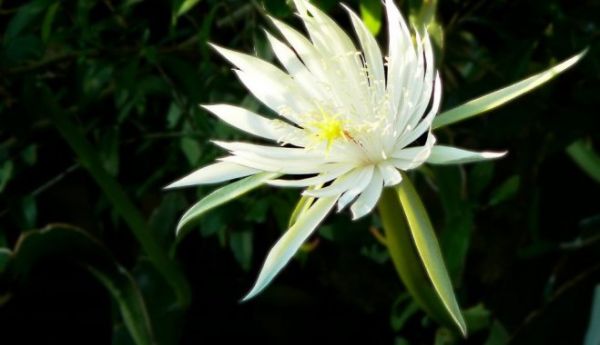

The queen of the night, or epiphyllum, popularly referred to as the "Dutch pipe", is one of the most popular and widespread cacti native to Central America and northern South America. The “queen of the night” blooms very rarely and only at night. Often, the buds ripen for a whole year, but even in such cases, the flower does not please the eye for long - the sun rises, and the luxurious bud is already withering.
The Chinese use the hieroglyph for epiphyllum to describe someone who quickly became famous and faded just as quickly - “caliph for an hour”.
Fragrant tobacco
This plant is annual, with a straight stem, reaching a height of up to 80 cm. Its leaves are large, round at the base, and elongated on the stems. The flowers are single, non-double, shaped like a gramophone, a kind of asterisk on a long tube. The color is mainly white, but there are also transitioning colors into other shades.
Fragrant tobacco is appreciated, of course, for its persistent pleasant aroma. Flower also refers to night colors
, opens its buds in the evening, and flowers close in the morning. Just like at night, tobacco smells fragrant and in cloudy weather.
For early flowering, scented tobacco is best grown through. Loves light, warmth, watering and feeding. It is possible to grow it in a composition with other flowers, but it must be borne in mind that it grows a lot. By the way, it has nothing to do with smoking tobacco.
Alissum
This shrub is also commonly known as "Burachok"... The plant is undersized, herbaceous. Height can vary from 20 cm to 40 cm. Strongly climbing shoots grow widely, intertwining with each other. There are flowers on the shoots - small, with four petals. Their colors are very different - white, pink, lilac, purple, lilac, yellow. The flowers, although unremarkable in appearance, bloom very densely and create the appearance of a dense carpet.
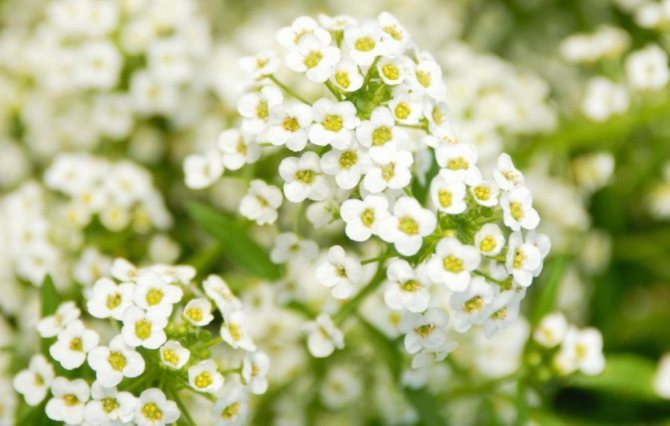

And although alyssum flowers cannot boast of a bright appearance, they have a very bright aroma - they smell sweetly of honey, and with the onset of night this heady aroma only becomes stronger and more distinct. Therefore, a flower planted on a site can perform not only a decorative function, but also play the role of a honey plant... Alyssum blooms for a long time.
Matiola (night violet)
Another night flower
... Mattiola is an annual ground cover plant. In terms of the beauty of flowers, it may be inferior to other flowers, but flower growers love it for its wonderful honey aroma. The color of mattiola flowers ranges from pale pink to bright purple. All night long, Mattiola exudes a sweet scent, no wonder it is called the night violet. If you plant Matthiola under a garden window or in a container on your balcony, you can have an aromatherapy session all night.
Matthiola can be planted directly in the ground in April-May. Mattiola is a cold-resistant plant. But it will begin to bloom only in July. If you want to bloom in June, plant it in seedlings in March, and in the ground in early May. For long flowering, like all annuals, it is advisable to remove faded flowers.
Dragon fruit chilocereus


Chilocereus are called "Night Cacti" because they bloom only at night. Their flowers are white, large, with a pleasant smell and a shape typical for cacti. Just like epiphyllums, chilocereus bloom for a short time - less than one night.
After 30-50 days, in place of wilted flowers, pitaya ripen, they are also dragon fruits, they are also called strawberry peaches. Under natural conditions, the fruits of this cactus ripen 5-6 times a year. Each fruit weighs between 150 and 600 grams.
They grow in Central and South America, and in Southeast Asia they are grown on plantations.
Short sayings and beautiful phrases about flowers for no reason
Women are like flowers ... Someone is allowed to bloom for a short time, and someone passes from age to age, preserving beauty and aroma for many years from the moment of blooming and flowering until the saddest hour of petals falling.
All the same, it's nice to receive flowers, it's so simple, unexpected, when you think that this is a simple day, and not a holiday at all, and then having received a bouquet of flowers in the morning, the mood immediately rises, you shine all day ... thanks ...
I didn't tell him that I loved purple roses. It's too personal for me.
She had never been given flowers for no reason before. She felt at that moment as if she had been given the whole world.
She: damn it, they bring flowers to the grave, what do you do to me ... He: and what do you offer me?
I will give you flowers ... You will die of allergies !!!
There is more life in the rapidly fading flower petals than in the heavy thousand-year-old blocks of granite.
Where flowers degenerate, man cannot live.
Desires are the flowers of love, and pleasure is its fruits.
Flower beauty: - in one flower.
You should never listen to what the flowers say.You just have to look at them and breathe their aroma.
For other women, a bouquet of roses is not enough: they still demand that the man change the water in the vase.
One rose given by a poor student expresses more than a huge bouquet given by a millionaire.
For my last birthday I was presented with a lot of flowers! True, everyone is in Odnoklassniki ...
Instead of complaining about the rose's thorns, I rejoice that a rose is growing among the thorns.
Beloved girls are given flowers, not tears!
Flower lover! You have become an inconspicuous slave to chrysanthemums.
Roses instill a love of nature, and thorns instill respect.
I don't believe women who say they are indifferent to flowers. They just didn't get them from their beloved men ...
A simple chamomile donated just like that will say much more than a scarlet rose presented for your birthday!
A favorite flower is, first of all, the rejection of all other flowers.
Happiness is not in the number of donated roses, happiness is in the person who gives them ...
Men distinguish between two types of flowers: - roses and "what are these called?"
Chrysanthemum - the last chord in the autumn symphony of colors - has long conquered the whole world with its beauty ...
Let the book of life open to you only the most beautiful pages, the river of hope flows joyfully, - flowers of love bloom along the banks !!!
If you have found keys to a woman's soul, take care of her, be for her like a gardener for flowers !!!
If a husband gives his wife flowers for no reason, then he just saw this reason.
Of course, I understand that flowers are a waste of money, they will quickly fade and that's it ... but damn it, it's so nice when they are presented!
Every woman loves to be given flowers until she finds out that others are given diamonds.
Better one humble flower and many feelings.
Flowers as a gift ... A trifle, but how nice!
Agree, a girl with a bouquet of flowers is much more beautiful than with a bottle in her hands ...
Having called a woman a flower, do not forget to choose the right fertilizer!
Flowers, like people, are generous for good and, giving people tenderness, they bloom, warming their hearts, like small, warm fires.
Love ... is like a rose flower. Just as beautiful and just as unpredictable.
I prefer a man to be good in bed!
Features of the
Enotera is a very vivid rhizome plant that belongs to the Cypress family. It blooms very beautifully, and reaches a height of up to 120 cm. This genus has about a hundred species of 1-year-old, 2-year-old and perennial plants. They can be both very small and tall. You can find this flower in Central America and Europe.
What do they look like?
If you see the flowering of a primrose (evening primrose) at least once, you will never forget about it. The stems of the night candle fall firmly downward; they can be straight or creeping. Leaves are oval-elongated, their petiole is short. It's funny that they look like donkey ears, which is why one of the names of this flower is primrose. The smell of flowers is very delicate, and the color can be pink, lemon yellow, white and even blue.
Bloom
These flowers bloom in the pre-twilight time, evening primrose blooms very quickly, in a matter of minutes. Her life is very short - just one night. In the morning you will find a wilted bud, and in the evening she will again give everyone her bright light, shining like a candle. In cloudy weather or in the shade, a night candle can bloom during the day. It blooms throughout the summer. In place of a flower that has already bloomed, a solid box with seeds appears. They will mature by September and will be up to 4 years old.
Care
This flower is very fond of the sun, although the light shade of the trees will not harm it. It is very unpretentious to the soil, it can grow in the garden, and in clay and sandy soil. All plant species are very drought tolerant. Excess moisture leads to the fact that the roots begin to rot, then the flower dies. Watering is necessary only during periods of severe drought. This plant is not susceptible to disease, of course, if it is properly cared for.Evening primrose is very good at transplanting.
Interesting
Among the etoners there is such a species, the fleshy root of which is used as a vegetable, it is called "Oenothera biennis", "rapontica", "rapunzel".
Fertilizing and feeding evening primrose
In order for the evening primrose to grow quickly and bloom magnificently, gardeners are advised to use top dressing. Before flowering, evening primrose is fertilized with superphosphate, at the rate of 1 tbsp. l. for each sq. m. At the very beginning of flowering, it is recommended to fertilize flowering plants or fertilize with calcium sulfate.
Before the beginning of flowering culture, feed it with mineral fertilizers
Attention. After you apply the fertilizer, the plant needs abundant watering.
Lily Casablanca
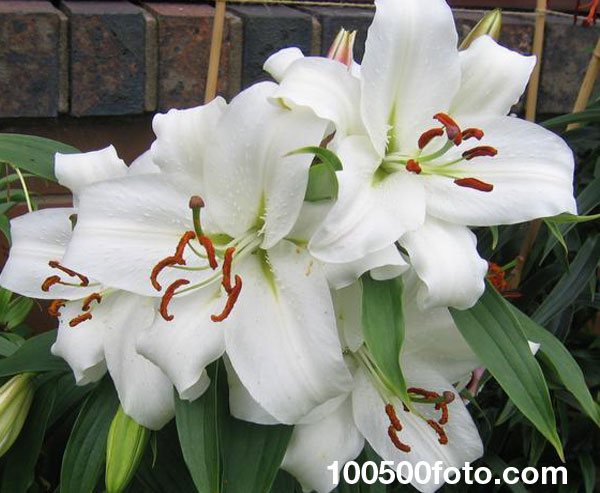

You've probably seen these flowers. Casablanca is widely used in perfumery and weddings. It belongs to the genus of lilies, numbering more than 110 varieties. Each flower has 6 petals and colors range from white, yellow, purple, orange to pink. Just imagine how beautiful it will be if you plant all the colors of this lily in the garden. Casablanca's flowers are elegant, delicate and also smell great.
Aromas of the Evening Garden: a selection of the best varieties of fragrant flowers
For about 400 years, no one in Japan knew that it even existed, because it was grown in closed gardens. It is now available to everyone around the world as a houseplant.
Begonia
Begonia is a very common houseplant in Russia, but few people grow it correctly. Ideally, a begonia in a small planter has hundreds of flowers! Begonia must be protected from drafts and kept warm, then it will delight you with a whole bouquet and a wonderful aroma.
Orchids
Some orchid varieties smell insanely delicious (eg, Corsage Orchid, Oncidium Orchid). The main thing is to choose the right variety. Caring for such an orchid does not differ from the usual one, but due to its rarity it costs 2-3 times more.
Oregano
We are used to growing oregano in the garden beds, but at home it looks no less beautiful because of its "fluffy crown", and it smells just fine. It is the perfect plant for the kitchen!
Passionflower
Another very moody plant that smells good is passion flower. All those who decided to grow it had to go a long way of trial and error. Since the plant loves extremely humid and warm sub- and tropical climates, you will have to tinker with it.
Hoya
This extraordinarily beautiful, deliciously smelling and at the same time also a liana plant, which has an unusually bright color, is called hoya (wax ivy). In the format of a houseplant, it is not yet very popular in Russia, but it can be grown.
Brugmansia
Snow-white brugmansia, as well as other types of brugmansia, are an excellent choice for a large planter in the living room on the floor. Tropical plants of the genus Brugmansia from the Solanaceae family are very popular with Spanish gardeners.
Plumeria (plumeria)
Among indoor plants, plumeria is not very common, simply because not everyone knows how delicious its flowers smell. Plumeria needs to be transplanted annually, which is easy enough, but every time you need to buy a larger planter.
Fragrant indoor plants
You can enjoy the aromas of exotic flowers almost all year long at home. Many scented houseplants are known. Each of them has its own unique smell and you can easily choose a home flower to your taste.
Among the many plants that people grow in their homes, there are species that are completely odorless or with a faint, almost imperceptible, aroma of fresh foliage or cut wood. The average person does not distinguish between such faint smells. It is these types that are recommended to be used as indoor plants for offices, because it is no secret that for some people, the fragrance of flowers causes headaches, and everyone has different tastes.
All scented indoor plants can be roughly divided into two large groups:
- only flowers have aroma
- all parts of the plant smell, the smell intensifies when damaged
Houseplants from first group
only during flowering delight with aroma. This group includes some orchids, stephanotis (Madagascar jasmine), roses, gardenias, and some cacti. It should be noted that almost always among the representatives of the same genus of fragrant flowering plants there are those that do not smell. The breeders have made sure to please all buyers: among the many hybrids, you can always choose an orchid completely odorless or with a pleasant exotic aroma.
Stefanotis
or Madagascar jasmine is a semi-shrub vine that prefers well-lit windows. White stars of flowers have an exquisite aroma. The plant needs support and careful regular maintenance.
Gardenia
quite a capricious plant.
Evening primrose: growing conditions and care
Enotera is sun-loving, prefers a sunny location, although it grows well in the light shade of trees. The flower is undemanding to the soil, it can fully develop both on cultivated garden soil, and on soil with a high content of clay and sand. All species are drought tolerant. Excess moisture leads to decay of the roots, which means the death of the flower. Therefore, the land near the bushes must be systematically loosened and the ubiquitous weeds must be removed. Water only during dry and hot periods, when the soil dries out a lot. Evening primrose flower is frost-resistant. It hibernates in garden soil without any shelter. With sufficient care, it does not get sick.
Evening primrose is easily propagated by seed and self-sowing. If the seeds are not collected at the end of September, they, having spilled out of the capsules, can be spread by ants far from the mother plant. Therefore, it is not surprising if in the spring in the most inappropriate corner of the garden evening primrose sprouts are found.
Vegetative reproduction of evening primrose is the most convenient and simple way. In May or autumn, the bushes are divided into divisions and transplanted to the planned place. The evening primrose plant tolerates transplanting well, even when it blooms.
When planting a culture, it must be borne in mind that adult specimens occupy an area of about 1 m2. To make the flower look neat and compact, its lateral shoots are cut in half. From this procedure, the plant looks neater, and much more buds are tied.
Brugmansiya, or fragrant dope
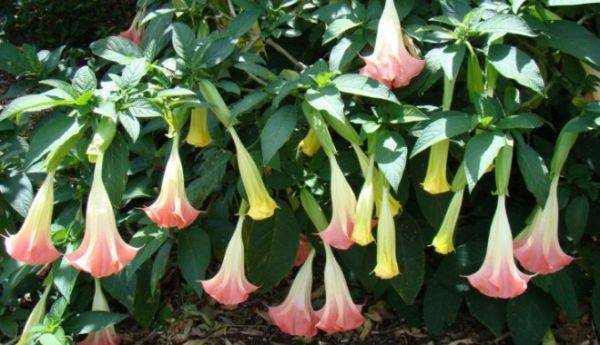

Brugmansiya or Datura is often called "prickly" or "damn apple". The flowers of this luxurious plant can reach very impressive sizes and smell very tasty.
Although Datura blooms during the day, you can truly enjoy its beauty on warm, quiet summer evenings. Datura flowers are half-closed and drooping during the day, but in the evening they open their buds and lift the leaves.
Despite their tropical origin and impressive appearance, almost all datura are native to South America and do not require too high a temperature to breed. But they must also be protected from the winter cold, best of all, the dope hibernates in greenhouses and cellars.
In natural conditions, datura reaches 3-5 meters in height. The plant is very poisonous, in the old days it was used to get rid of enemies.
General information about the Mirabilis plant
Mirabilis is a tall plant with many straight shoots and beautiful flowers. No special skills are required to grow it.
Origin
The night beauty was brought to Europe from South America, from Mexico in the middle of the 18th century, after Spain conquered Mexico.
It is believed that the Aztecs were the first to grow the night beauty.


Mirabilis got its distinctive name for the fact that the opening of buds and flowering occurs in the evening and at night.
Night beauty has a unique and strong aroma. Therefore, for those with allergies, this plant is not suitable.
Features of life
Mirabilis accumulates strength all day, and in the evening it opens its flowers.
At the same time, in gloomy weather, the flowers of the night beauty open earlier and last longer.
In the bright sun in the heat, the flower opens when the night coolness begins, and withers faster in the morning.
If mirabilis grows in a garden, then it is important where in the garden it grows, how often and at what time the sun shines it.
During the day, the night beauty will curl up into a tube. Even after the plant has bloomed, the bright green leaves of mirabilis make it attractive.
Color spectrum
Mirabilis has a large number of colors of its flowers, and even on one bush there can be up to five buds of different colors.
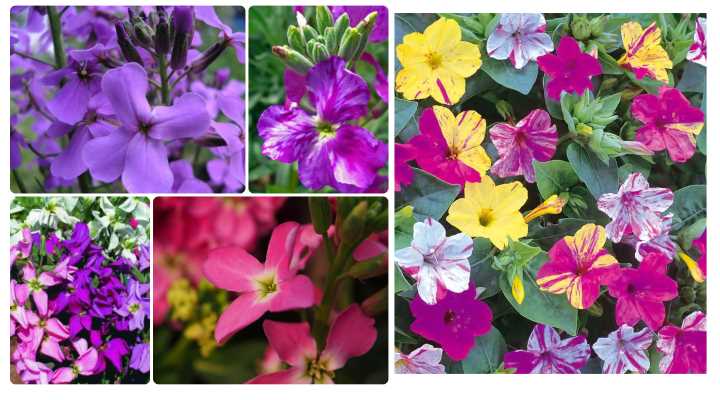

A night beauty plant in which the color of flowers goes from dark or black to white buds will look very beautiful and spectacular. There are also peduncles that have a striped color, rainbow.
Reproduction
The ways
Mirabilis propagates and is grown in two main ways:
- by sowing seeds and
- planting tubers.
Seeds
Sowing should be done in late March or early April, in Siberia and the Far East - in early March.
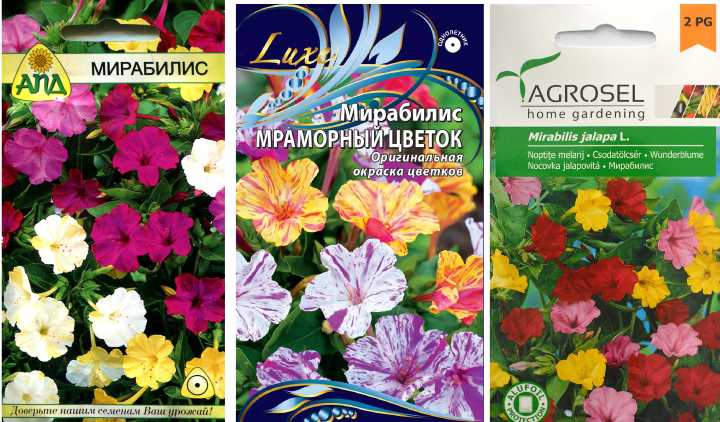

If these conditions are met, the night beauty will take root and develop.
- Before sowing, the seeds must be soaked in warm water for a day, this will soften the hard shell, which is saturated with water.
- Any soil can be used for sowing, for example, universal, since mirabilis is not picky.
- The seeds are planted in damp ground for half a centimeter, and then watered with warm water.
- The container with soil and planted seeds is covered with glass or foil and removed to a warm place.
- In two or three weeks there will be shoots, you can remove the shelter and put the container on a warm windowsill.
- During the day, when it is warm, the plant can be taken out to breathe in the fresh air.
- After the frost stops, you can plant the plants in open ground, preferably in rainy weather, so that they quickly take root in their new place.
Tubers
If you bought tubers in the store in the winter, then until planting you need to store them in the refrigerator on a shelf intended for vegetables.
Mirabilis tubers can be planted in open ground when the soil warms up to a depth of 11-15 centimeters in the second half of April or early May.
In freezing conditions, the sprouts can be covered overnight with plastic bottles, after which the cover is removed for plant freedom. Too long and weak shoots of a night beauty need to be pinched so that about 10 centimeters remain.
It is better to choose the soil for planting mirabilis that is not very acidic, for example, loamy soil. The area where mirabilis will grow should be light, because in the shade the plant grows and blooms worse.
Seat selection
It is also important that the night beauty is a plant that loves space, and can survive its neighbors from the site.
Can be planted close to a fence to form a hedge.
Mirabilis also has undersized varieties that are grown in pots or flower beds. Such varieties look good next to tall roses, delphiniums, peonies.
In general, mirabilis is a plant that does not require special skills when planting and caring in the open field, it can be well shaped, pinched, pruned. For beauty, shoots can be formed by trimming the stems in the form of a ball or pyramid, after which they will be covered with flowers.
A lovely night candle or evening primrose is a wonderful addition to your garden
I'll buy flowers for him myself ...
Artificial flowers don't smell. So artificial relations do not bloom.
Flowers bring the greatest joy when they are presented not on a birthday and not by a nasty husband, but ... just like that!
I often gave her flowers, and you know what I understood: - in a relationship, a man is just a mediator. Some women sell flowers to other women through you.
On a date, tell your girlfriend that she is beautiful and then fuck her face with a bouquet. Girls love flowers, warm words and strong men.
Hesperis
Night violet reproduces by seeds, next year self-seeding. After planting, flowering will begin only by the next year. You can sow at any time of the year except winter. This plant tolerates cold well and blooms for two months, depending on watering and the intensity of the heat.
Alissum
Globular shrub with white pink and yellow flowers. Not whimsical enough to care. Blooms until deep frosty, autumn days. Planting should be done in sunny areas, the distance between the bushes is not less than 30 cm due to its spreading. Water sparingly to avoid root rot.
Alyssum cannot be 100% called a night flower, because its flowering continues around the clock, but, like many night plants, it attracts with its smell, which comes from small flowers.
This plant can be successfully grown on balconies and verandas. Its dense greenery prevents unwanted weeds from growing.
Night plants
There is a huge variety of plants, thanks to which there is always the possibility of creating variegated and unusual flower beds.
Most flowers bloom during daylight hours, but there are nocturnal plants that begin to smell and bloom at night. Some of them bloom day and night. Nocturnal plants are pollinated by insects and small mammals such as bats. Houseplants that bloom at night are pollinated by themselves or require artificial pollination.
Among the most famous nocturnal plants is the nocturnal violet or hesperis (popular among the people). With the onset of evening, the crimson nocturnal flowers begin to smell intensely. Vechernitsa belongs to biennials, perfectly tolerates winter cold without additional shelter.
Perennial evening primrose also appears in all its glory only in the evening. The large flowers have a pleasant aroma that fills the entire garden. Evening primrose requires some care and attention. Evening primrose is used to create rocky slides, curbs, mixborders.
Annual Matthiola is grown for its beautiful flowering. In the evening, the honey aroma of flowers intensifies. It is especially pleasant to spend evenings in the gazebo, next to which the mattiola is planted. It is often used for landscaping balconies.
Fragrant tobacco is one of the nocturnal plants. This annual is distinguished by unobtrusive, but bright flowers, as well as a special aroma, which intensifies in the evening. Fragrant tobacco pleases with flowering throughout the day and night.
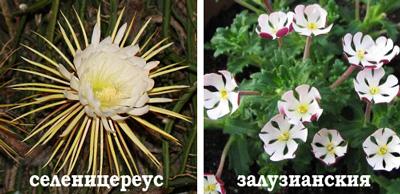

Selenicereus cactus blooms exclusively at night. The flowers are large and fragrant. No wonder he is called the queen of the night.
As soon as night falls, the Zalusian is in all its glory. Its flowers give off a pleasant aroma reminiscent of vanilla.
The amazing mirabilis blooms in the late afternoon and for the whole night, while the air is filled with a unique aroma. By morning, the flowers wither, but the next night new ones bloom, but due to their daily blooming, the impression of a continuous, long flowering is created.
Epiphyllum is also called the queen of the night for its beautiful flowers, which are white, red, pink, cream, yellow.
Night plants include the wonderful brugmansia, whose flowers resemble huge gramophones. With proper care, brugmansia will delight with abundant flowering. However, there is a danger behind the beauty - the plant is among the poisonous.
Garden night plants create an atmosphere of romance, especially if you go out into a garden filled with aromas of flowers, sit in a lighted gazebo with a cup of tea with loved ones. They bring mystery, enigma to the garden, which gives the impression of something magical and unique.
How many interesting things nature has created. When looking in any direction, we can see majestic trees. In the summer, going out into the street, we see colorful flower beds filling the air with fragrance. The variety of colors is amazing.Throughout the spring and summer season, you can enjoy flowering by planting plants so that the flowering of one will be replaced by the buds of another flower. But what if there is an opportunity to prolong the beauty even at night? When the daytime bloom closes or fades, nighttime blooms take over. And although they may not be so chic outwardly, the scent that they spread around them is unforgettable.
Evening primrose
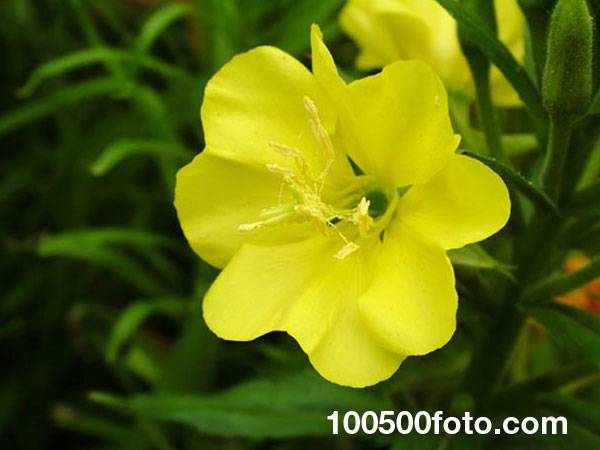

This plant is native to North America, but today primrose can be found in Asia, Europe, New Zealand and even Australia. Beautiful yellow flowers open only in the evening, for which this flower received such a name. The seeds, leaves and roots of this plant are widely used for medicinal purposes. Just at night, insects appear that pollinate these flowers. Evening primrose grows to a height of 3 to 5 feet and flowers up to 2 inches.
Fragrant flowers for home and balcony
Finding flowers that smell good is a special challenge. In this case, you need to take into account several important points at once:
- the right combination of aromas;
- harmonious combination of plants in terms of design;
- what conditions are suitable for different plants for their joint flowering (soil, illumination, and others).
Important! In the case of the selection of aromas, it is also important to take into account the presence of allergies in someone from home to certain odors. And if plants with a smell are supposed to be grown at home, accordingly, you need to keep in mind pets, who may also not like too fragrant flowers.
The most intense, tasty-smelling plants can be placed on your balcony. The most popular are:
- Gloxinia - plants with incredibly beautiful flowers in the form of gramophones. They have a wide variety of colors and patterns and have a delicate, distinctive aroma.
- Hyacinth Are very popular flower plants that are grown from bulbs. They have a very intense aroma exuded by flowers of all kinds of colors: blue, red, white, pink, lilac, etc.
- Sweet pea blooms all season until early October, if the Indian summer is delayed longer than usual. The plant is creeping and needs trellis, netting or stretched ropes.
- Lavender - a graceful plant with purple flowers that enrich the atmosphere with a pleasant scent until the end of summer.
- Nasturtium - it can be grown like a grapevine on a trellis, or in ordinary containers. The aroma is pronounced, with rich honey tints.
Moon flowers
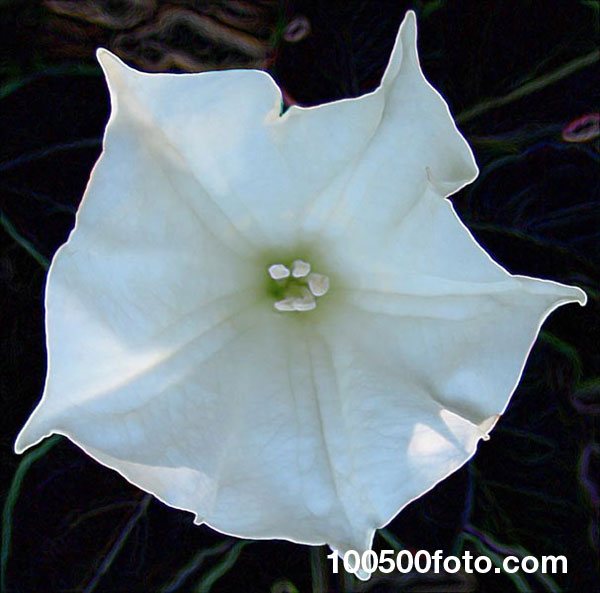

Moon flowers (the botanical name for morning glory) get their name from the fact that they bloom in the moonlight. These flowers are pink or white. In the dark, morning glories open quickly and are in loose form all night long. As soon as the sun's rays touch their petals, they immediately close. This plant reaches 15 feet in height. Propagated by seeds.
Night beauty flower care rules
Humidity
In hot weather, mirabilis should be sprayed with water in the evening, and watered once every 4 days, because excess moisture can cause the plant to stretch too far and stop blooming.
Top dressing
Top dressing should be done once a month with organic fertilizers, so mullein or bird droppings can be applied to the root area.
What if there is no way to provide a litter?
In the absence of such organic matter, you can dilute humate and pour over the root part.


Pruning
Night beauty is a perennial plant, therefore, in the fall after the onset of the first frost, you need to cut off the green shoots, leaving 10 centimeters from the ground and leave them to dry.
After that, dig out the rhizomes, let them dry in the sun, put them in boxes and cover them with dry sand or sawdust. This is an essential part of plant care.
Storage of tubers
Nodule plants are stored in a basement at a temperature of at least five degrees.
It is also important to make sure that the flowers of the night beauty do not start growing too early, and if buds appear, then move the tubers to a cool place, such as a refrigerator.
And in the warm southern regions of Russia, mirabilis winters well in the soil, the main thing is to cut off the shoots and insulate the soil with straw or sawdust.
"Four o'clock"
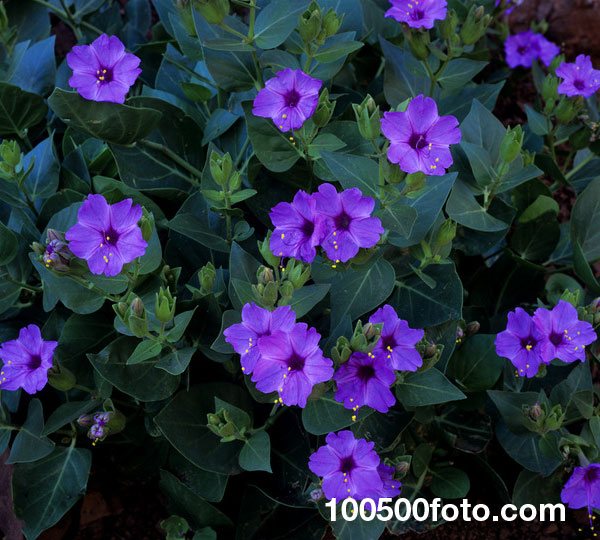

These beautiful delicate flowers that bloom at night are a perennial plant. Their botanical name is Mirabilis Yalapa. They bloom in spring and summer. Four o'clock comes in red, white, pink, blue and yellow. Such flowers begin to bloom at four o'clock in the afternoon, which is why they got their name. These flowers make great hedges. When they bloom, they give off an excellent aroma. The birthplace of Mirabilis Yalapa is Mexico.
Rules for creating a fragrant garden in the country
Creating a fragrant garden is an original and interesting task. The main requirement for work is the formation of plantings of such plants that will constantly produce flowers at different times of summer and autumn. In short, you need to create a garden of continuous flowering and fragrance.
Along with the conditions of design and agrotechnical (according to the conditions of care) combination, it is necessary to take into account, so that the flowers bloom in turn, and their aromas do not interrupt each other:
- The first to open the season of fragrances in the country hyacinths and daffodils. They are planted in the form of seedlings, which they begin to prepare at the end of summer. A bulb is planted in a container, and at the very beginning of October it is dug into the ground along with a seedling. The next year, with the onset of the warm season, the pots are removed, the plants are removed and planted in specific locations.
- Next, a shrub popular in our latitudes begins to bloom - lilac. This is a rather unpretentious plant that chooses different types of soil. Along with the usual tall trees, you can also plant decorative shrubs, which grow no more than one and a half meters in height. Such trees not only bloom beautifully, but also look great in rockeries and other options for flower arrangements.
- At about the same time, it blooms bird cherry, whose flowers smell like honey. Its flowering time is mid-May. A garden apple tree is laid at about the same time, saturating the air with a delicate aroma.
- Following (second half of May) bloom lilies of the valley. These flowers are undersized, have a very peculiar, recognizable appearance, therefore, they are most often planted separately from others. With their help, you can designate garden paths, plant around the edges of the flower bed in circles or patterns, and also plant in the form of a solid green carpet.
- Then the time comes chubushnik... It blooms at the very beginning of June and throughout July. Not all of its varieties smell, so it is important to choose fragrant ones. It is fragrant with such pleasant aromas that it is called garden jasmine. The aroma is pronounced, rich, harmonious. It is best to plant this plant in open, sunny places and do not forget about regular watering.
- The beginning of June is also the time iris cereal. The aroma is sweet, fragrant. Also this is the time of the so-called fragrant vines - different types of honeysuckle. Their flowering time is not very long, but the aromas are very rich.
- Goof silver - a plant with a peculiar smell that resembles delicious soap. Blooms closer to early July.
- Midsummer is the time for flowering daylily lemon. Dozens of buds and, accordingly, flowers on one stem are formed. Therefore, the aroma from it comes quite strong.
- End of July - time lilies of different types. A distinctive feature is that the smell from them begins to intensify closer to midnight.
- It's time in August black cohosh racemose. Its smell is very peculiar, with a slight sourness.
- And around the same time, flowers of different varieties begin to bloom. geraniums, the peculiar smell of which is familiar to any gardener.
Flowers-bedside lamps for the balcony
- heliotrope;
- cloves;
- matthiola;
- heiranus.
According to the site Arguments and Facts
All parts of the plant can have a smell. Most often, we pay attention to the aroma of flowers, but fruits, leaves, stems, roots also smell. Moreover, sometimes it is completely different in the same plant, as, for example, in valerian. Some green "perfumers" more actively emit their fragrances in the sun, others begin to scent in cloudy weather or even at night, and still others respond to touch. Smells are pleasant and unpleasant, subtle and harsh, attractive and repulsive.
The garden of fragrances. What bushes do romantics and butterflies choose?
A very peculiar strong aroma, for example, is inherent in large-rhizome geranium. To some, it may seem exciting, while to others it may seem too harsh. This is natural, because the perception of smells is individual, and the fragrant composition of this plant is very complex. It contains both woody and fruity notes, and - quite unexpectedly - notes of musk. Moreover, the aroma is manifested with a light touch of the bush. Like a plant warning: this is my territory.
By the way, this type of geranium is very unpretentious and, growing luxuriantly in inconvenient places, is able to mask the most unsightly corners. At the same time, it cannot be called an aggressor: the roots do not cling too tightly to the soil, and the shoots break off easily, so the plant is easy to keep within the bounds of decency. The queen of fragrance. How to grow lavender in the garden Read more
The scent of lemon is loved by many: it evokes associations with purity and freshness. It is remarkable that it is inherent in the leaves of many plants that have nothing to do with citrus fruits. For example, lemon balm, lemongrass, some varieties of thyme, basil. But a particularly strong citrus aroma, besides, with different shades, the monarda emits.
Epiphyllum
This plant is indoor. Large buds of the epiphyllum reveal all their beauty at night. Phyllocactus, as it is also called, grows in the form of a bush. Its long stems are more like leaves with spines on the sides.
Because of the beauty and size of the flower, it was nicknamed the cactus-orchid. Flowering of each bud lasts for five days and during this period it needs to be provided with complete rest. With proper care, spring blooms can recur during the fall season.
Chilocereus
At the end of the flowering period, the chilocereus cactus gives an unusual fruit - pitahaya, pitaya, or dragon fruit... However, when grown at home, the plant does not bear fruit.
This cactus is often grown in pots on the windowsill. He is unpretentious and undemanding. But it grows very quickly - a transplant is required annually and is carried out in the spring. When the cactus becomes very large, they try not to disturb it as much as possible. The only signal for transplanting is the roots, which are shown above the surface of the earth.
This beautiful flower has many names: primrose, onager, primrose evening and night candle... It happens both short and tall. Evening primrose growth ranges from 30 cm to 1 m. It can also be annual, biennial and perennial.
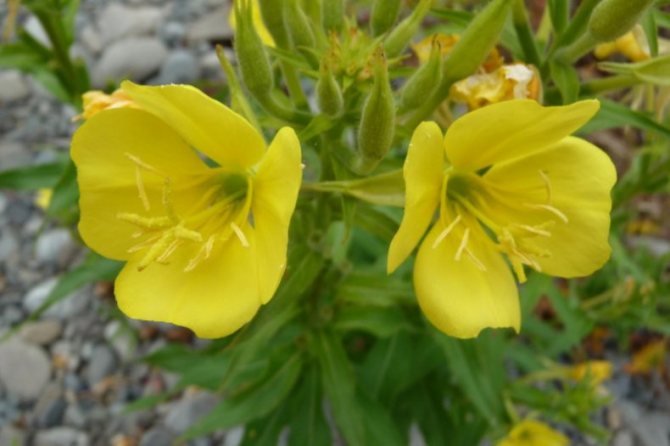

Evening primrose has long shoots that can be straight or creeping. On them, oblong oval pubescent leaves, similar to donkey ears, are located on short petioles.
Another cactus with beautiful large flowers, also known as phyllocactus.
It grows in the form of a spreading bush. The stems are long, flat, fleshy, resembling leaves. Spines are located along the edges. The branches are most often creeping and climbing, which is why the plant is mainly grown as ampelous. Aerial roots often appear on the stem.
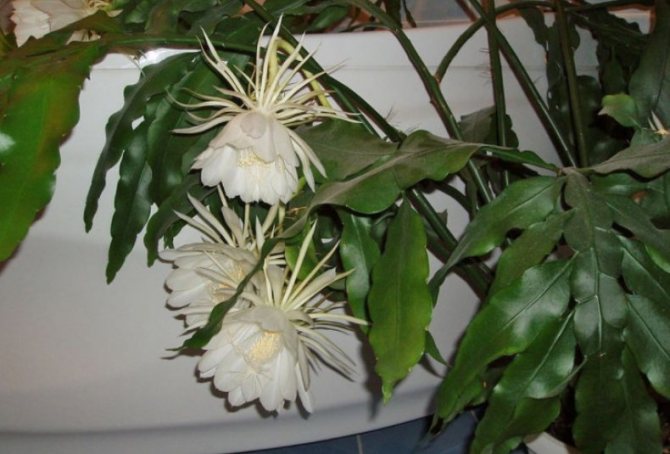

With good care, the epiphyllum blooms in the spring-summer period with very large flowers, which can be up to 40 cm in diameter. The color is white, cream, pink and red.
Night flowers are special plants. They bloom after dusk, decorate the evening garden with delicate flowers and smell amazing, forcing you to enjoy all facets of floral, spicy and sweetish aromas.
Read also: How to choose a garden vacuum cleaner for a summer residence
Fragrant representatives of perennial flowers
The pleasant-smelling perennials, of course, include roses. The wonderful aroma of these is perfectly complemented and set off by such spicy plants as sage, oregano, catnip, wormwood, geranium, cuff. The listed species have long been included in the suite of a flower of noble origin. When composing the composition, preference is given to multi-flowered varieties of polyanthus roses.
Only peonies can compete in the power of beauty and aroma with roses. The most fragrant of them are varieties of peony lactocyanin, the aroma of which can be felt at a sufficient distance from the plant. The strength of the scent of a blooming peony depends on the age of the perennial. The air temperature and humidity level affects the intensity of the smell. In the evening, peony flowers are not devoid of aroma, however, the scent picks up peak values closer to noon.
The peony bush during the flowering period is an adornment of any garden. The wonderful aroma of terry flowers spreads throughout the site, as if inviting to look at the hero of the occasion
Dozens of varieties of peonies have been bred with various aromas:
- sweetish;
- apple;
- lemon;
- floral;
- spicy;
- tart;
- musky;
- mint;
- honey, etc.
In addition to roses and peonies, a number of phloxes, lilies, daffodils, hyacinths, carnations and other plants can be attributed to fragrant perennials. Floral perennials are perfectly complemented by fragrant shrubs, including lilac, honeysuckle, white acacia, viburnum and many others.
For several years in a row I have been growing a biennial evening primrose in my garden, or it is also called a night beauty or a night candle. I remember buying seedlings of some flowers, and my grandmother gave me seedlings of this evening primrose as a gift. I planted it in the shade under an apple tree, where nothing ever grew, because I didn’t like the foliage at all, and I hadn’t heard about this flower until that moment. What was my surprise when two-year-old evening primrose not only grew but also bloomed.
It bloomed in the evening and unfortunately the first days I could not catch the moment of opening the flowers. But she already amazed me, from some sluggish green leaves a meter-long bush with large lemon-colored flowers grew. It burned in the night like a candle, it is not for nothing that it is called by the people “Night candle”. But what was my delight when I saw for the first time how at sunset the flowers of the night beauty, evening primrose, begin to open.


I saw this only on TV, when they showed the blooming of a flower in a quick shot. The bud burst, and as in a fairy tale, the pistil began to rotate and the petals unrolled and opened. I called all my relatives and we began to observe the further blooming of the biennial evening primrose. The bush was literally all moving and before our eyes, here and there, large, fragrant, bright yellow flowers of a night candle opened up. In the garden, only admiring shouts were heard: "Look, this one opens up, and here's another one ...". We stood in the garden until dark, until the last flower bloomed. Perhaps this fabulous evening remained in the memory not only of me, but also of my loved ones.
The next day we were already waiting for the sunset to see this sight again and experience a storm of emotions. We took a video camera with us and recorded this fabulous performance on it. So it turned out from an ugly duckling into a charming swan.
Evening primrose flowers close by lunchtime. And in the evening the tale repeats itself again. Evening primrose blooms from June to October, until the first frost.
5 unique garden plants that can be planted both in the flowerbed and on the balcony.

